BST190: Innovation Management
VerifiedAdded on 2022/01/15
|20
|5123
|41
AI Summary
Contribute Materials
Your contribution can guide someone’s learning journey. Share your
documents today.
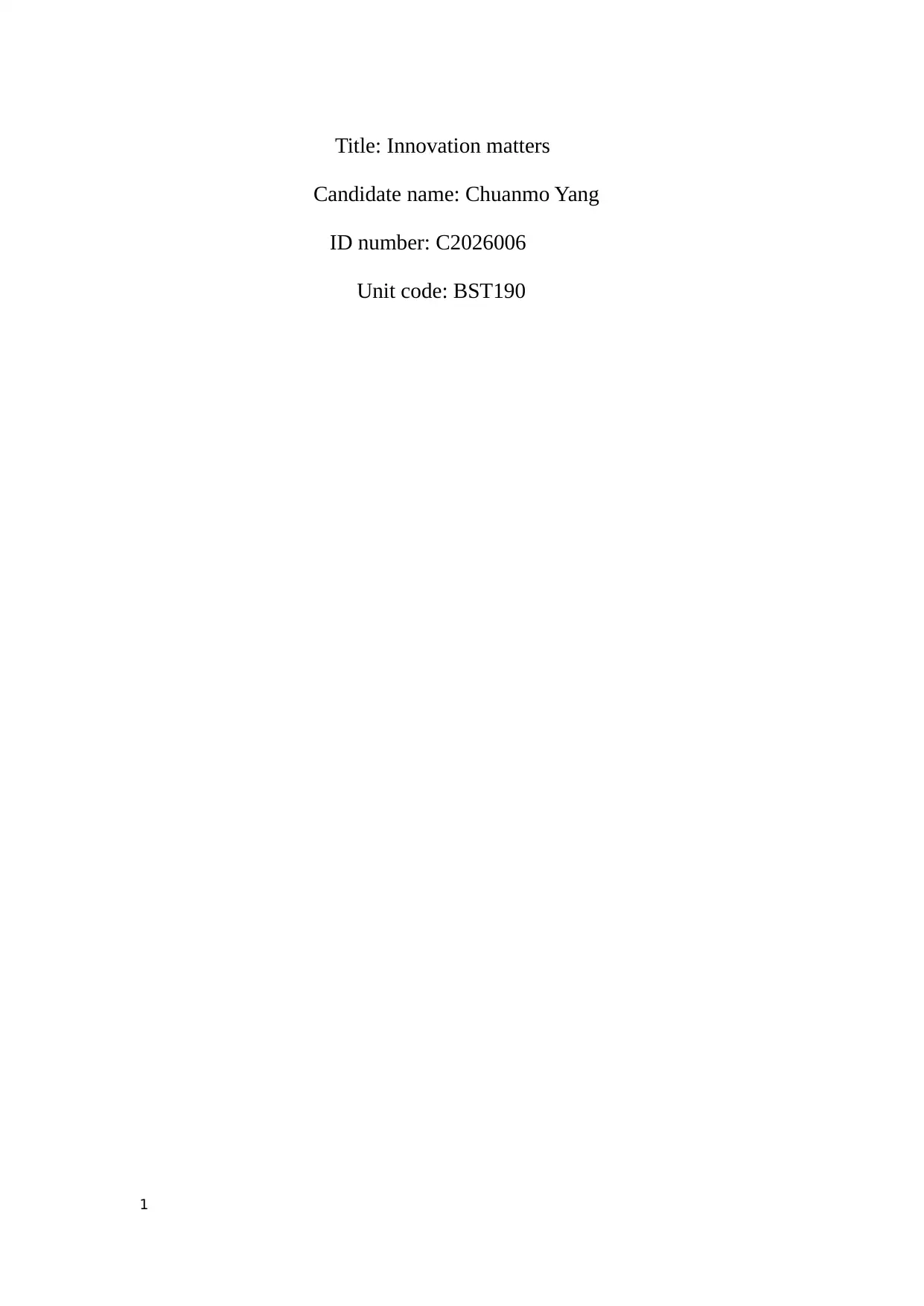
Title: Innovation matters
Candidate name: Chuanmo Yang
ID number: C2026006
Unit code: BST190
1
Candidate name: Chuanmo Yang
ID number: C2026006
Unit code: BST190
1
Secure Best Marks with AI Grader
Need help grading? Try our AI Grader for instant feedback on your assignments.
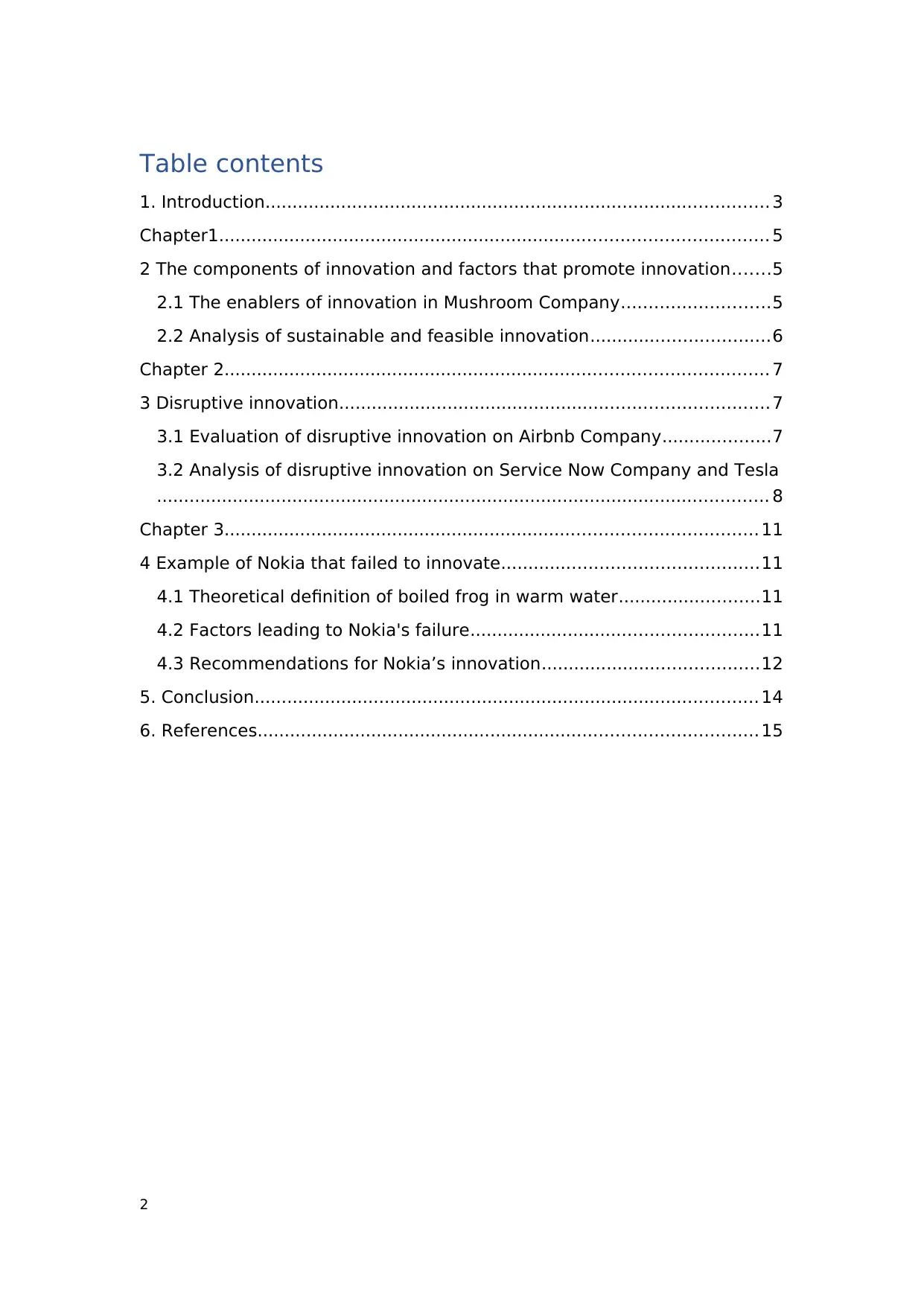
Table contents
1. Introduction............................................................................................. 3
Chapter1..................................................................................................... 5
2 The components of innovation and factors that promote innovation.......5
2.1 The enablers of innovation in Mushroom Company...........................5
2.2 Analysis of sustainable and feasible innovation.................................6
Chapter 2.................................................................................................... 7
3 Disruptive innovation...............................................................................7
3.1 Evaluation of disruptive innovation on Airbnb Company....................7
3.2 Analysis of disruptive innovation on Service Now Company and Tesla
................................................................................................................. 8
Chapter 3.................................................................................................. 11
4 Example of Nokia that failed to innovate...............................................11
4.1 Theoretical definition of boiled frog in warm water..........................11
4.2 Factors leading to Nokia's failure.....................................................11
4.3 Recommendations for Nokia’s innovation........................................12
5. Conclusion............................................................................................. 14
6. References............................................................................................ 15
2
1. Introduction............................................................................................. 3
Chapter1..................................................................................................... 5
2 The components of innovation and factors that promote innovation.......5
2.1 The enablers of innovation in Mushroom Company...........................5
2.2 Analysis of sustainable and feasible innovation.................................6
Chapter 2.................................................................................................... 7
3 Disruptive innovation...............................................................................7
3.1 Evaluation of disruptive innovation on Airbnb Company....................7
3.2 Analysis of disruptive innovation on Service Now Company and Tesla
................................................................................................................. 8
Chapter 3.................................................................................................. 11
4 Example of Nokia that failed to innovate...............................................11
4.1 Theoretical definition of boiled frog in warm water..........................11
4.2 Factors leading to Nokia's failure.....................................................11
4.3 Recommendations for Nokia’s innovation........................................12
5. Conclusion............................................................................................. 14
6. References............................................................................................ 15
2
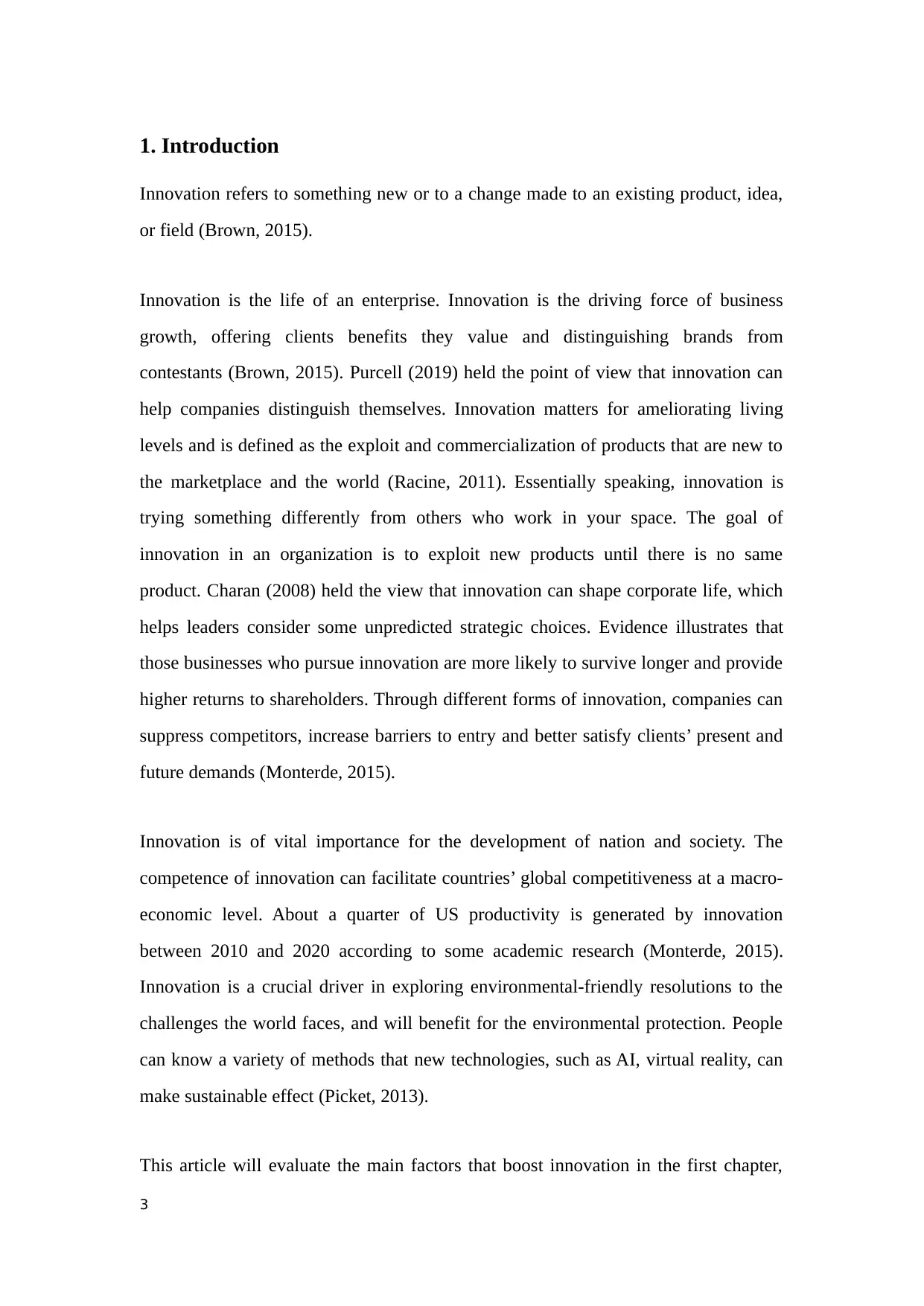
1. Introduction
Innovation refers to something new or to a change made to an existing product, idea,
or field (Brown, 2015).
Innovation is the life of an enterprise. Innovation is the driving force of business
growth, offering clients benefits they value and distinguishing brands from
contestants (Brown, 2015). Purcell (2019) held the point of view that innovation can
help companies distinguish themselves. Innovation matters for ameliorating living
levels and is defined as the exploit and commercialization of products that are new to
the marketplace and the world (Racine, 2011). Essentially speaking, innovation is
trying something differently from others who work in your space. The goal of
innovation in an organization is to exploit new products until there is no same
product. Charan (2008) held the view that innovation can shape corporate life, which
helps leaders consider some unpredicted strategic choices. Evidence illustrates that
those businesses who pursue innovation are more likely to survive longer and provide
higher returns to shareholders. Through different forms of innovation, companies can
suppress competitors, increase barriers to entry and better satisfy clients’ present and
future demands (Monterde, 2015).
Innovation is of vital importance for the development of nation and society. The
competence of innovation can facilitate countries’ global competitiveness at a macro-
economic level. About a quarter of US productivity is generated by innovation
between 2010 and 2020 according to some academic research (Monterde, 2015).
Innovation is a crucial driver in exploring environmental-friendly resolutions to the
challenges the world faces, and will benefit for the environmental protection. People
can know a variety of methods that new technologies, such as AI, virtual reality, can
make sustainable effect (Picket, 2013).
This article will evaluate the main factors that boost innovation in the first chapter,
3
Innovation refers to something new or to a change made to an existing product, idea,
or field (Brown, 2015).
Innovation is the life of an enterprise. Innovation is the driving force of business
growth, offering clients benefits they value and distinguishing brands from
contestants (Brown, 2015). Purcell (2019) held the point of view that innovation can
help companies distinguish themselves. Innovation matters for ameliorating living
levels and is defined as the exploit and commercialization of products that are new to
the marketplace and the world (Racine, 2011). Essentially speaking, innovation is
trying something differently from others who work in your space. The goal of
innovation in an organization is to exploit new products until there is no same
product. Charan (2008) held the view that innovation can shape corporate life, which
helps leaders consider some unpredicted strategic choices. Evidence illustrates that
those businesses who pursue innovation are more likely to survive longer and provide
higher returns to shareholders. Through different forms of innovation, companies can
suppress competitors, increase barriers to entry and better satisfy clients’ present and
future demands (Monterde, 2015).
Innovation is of vital importance for the development of nation and society. The
competence of innovation can facilitate countries’ global competitiveness at a macro-
economic level. About a quarter of US productivity is generated by innovation
between 2010 and 2020 according to some academic research (Monterde, 2015).
Innovation is a crucial driver in exploring environmental-friendly resolutions to the
challenges the world faces, and will benefit for the environmental protection. People
can know a variety of methods that new technologies, such as AI, virtual reality, can
make sustainable effect (Picket, 2013).
This article will evaluate the main factors that boost innovation in the first chapter,
3
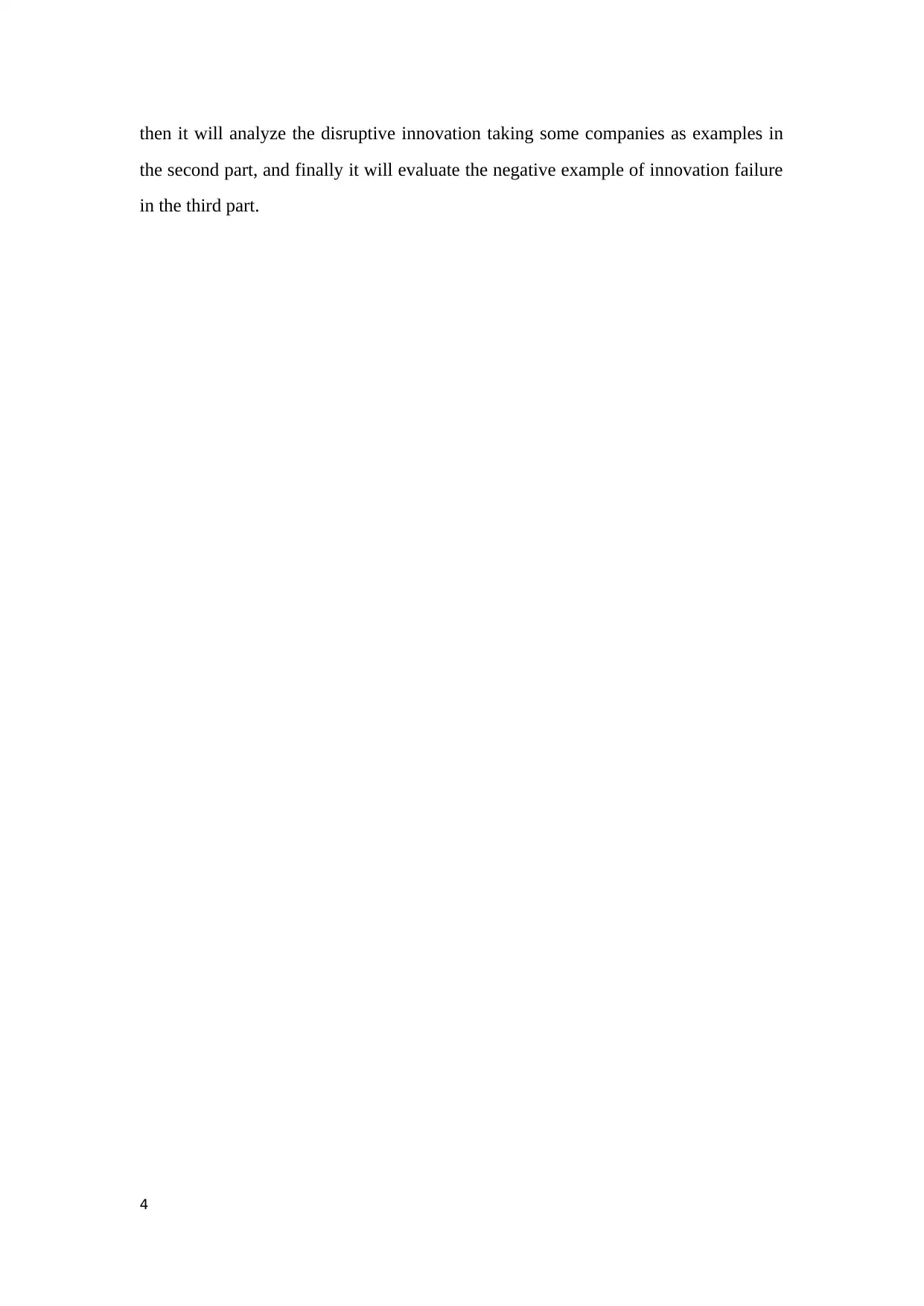
then it will analyze the disruptive innovation taking some companies as examples in
the second part, and finally it will evaluate the negative example of innovation failure
in the third part.
4
the second part, and finally it will evaluate the negative example of innovation failure
in the third part.
4
Secure Best Marks with AI Grader
Need help grading? Try our AI Grader for instant feedback on your assignments.
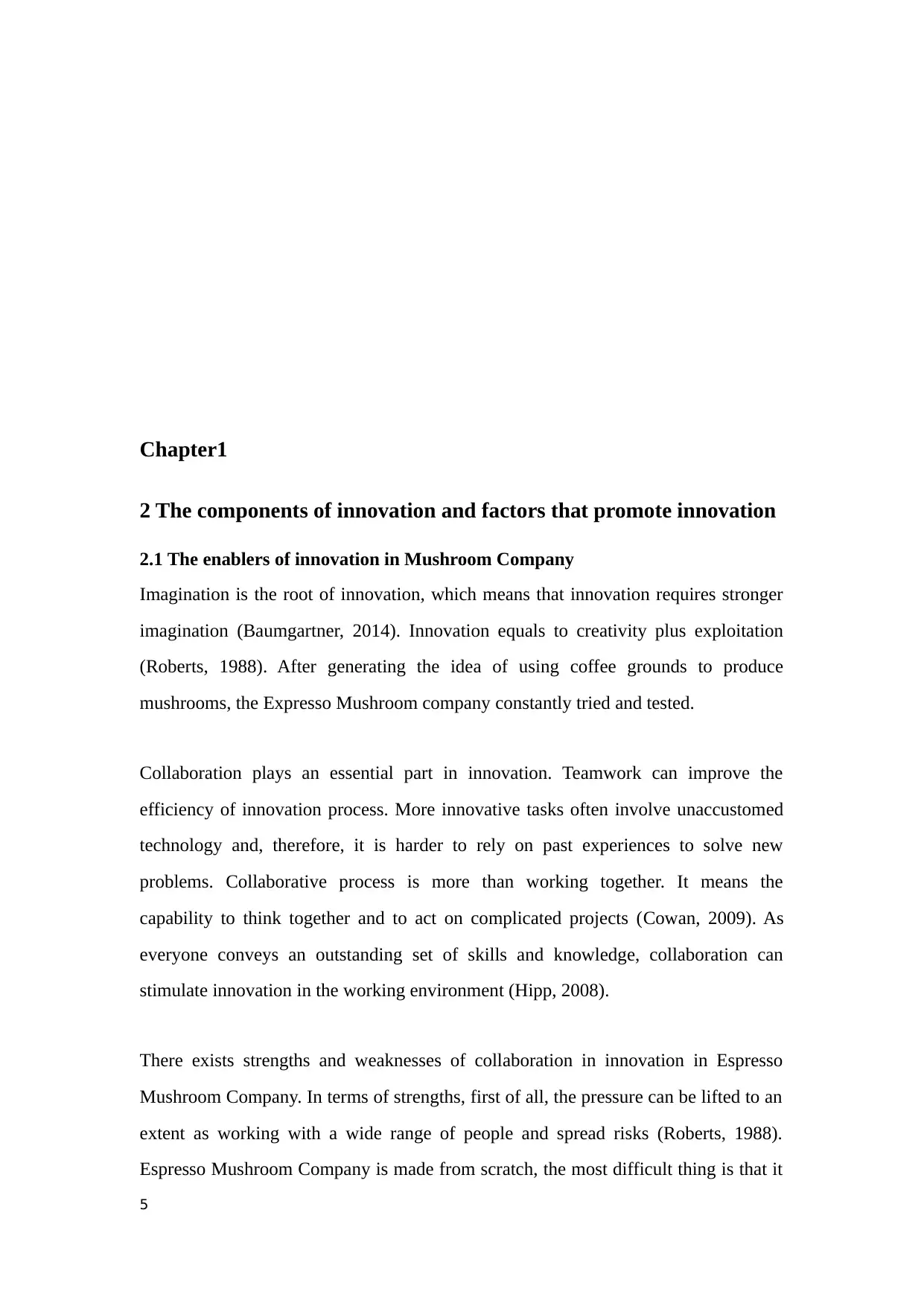
Chapter1
2 The components of innovation and factors that promote innovation
2.1 The enablers of innovation in Mushroom Company
Imagination is the root of innovation, which means that innovation requires stronger
imagination (Baumgartner, 2014). Innovation equals to creativity plus exploitation
(Roberts, 1988). After generating the idea of using coffee grounds to produce
mushrooms, the Expresso Mushroom company constantly tried and tested.
Collaboration plays an essential part in innovation. Teamwork can improve the
efficiency of innovation process. More innovative tasks often involve unaccustomed
technology and, therefore, it is harder to rely on past experiences to solve new
problems. Collaborative process is more than working together. It means the
capability to think together and to act on complicated projects (Cowan, 2009). As
everyone conveys an outstanding set of skills and knowledge, collaboration can
stimulate innovation in the working environment (Hipp, 2008).
There exists strengths and weaknesses of collaboration in innovation in Espresso
Mushroom Company. In terms of strengths, first of all, the pressure can be lifted to an
extent as working with a wide range of people and spread risks (Roberts, 1988).
Espresso Mushroom Company is made from scratch, the most difficult thing is that it
5
2 The components of innovation and factors that promote innovation
2.1 The enablers of innovation in Mushroom Company
Imagination is the root of innovation, which means that innovation requires stronger
imagination (Baumgartner, 2014). Innovation equals to creativity plus exploitation
(Roberts, 1988). After generating the idea of using coffee grounds to produce
mushrooms, the Expresso Mushroom company constantly tried and tested.
Collaboration plays an essential part in innovation. Teamwork can improve the
efficiency of innovation process. More innovative tasks often involve unaccustomed
technology and, therefore, it is harder to rely on past experiences to solve new
problems. Collaborative process is more than working together. It means the
capability to think together and to act on complicated projects (Cowan, 2009). As
everyone conveys an outstanding set of skills and knowledge, collaboration can
stimulate innovation in the working environment (Hipp, 2008).
There exists strengths and weaknesses of collaboration in innovation in Espresso
Mushroom Company. In terms of strengths, first of all, the pressure can be lifted to an
extent as working with a wide range of people and spread risks (Roberts, 1988).
Espresso Mushroom Company is made from scratch, the most difficult thing is that it
5
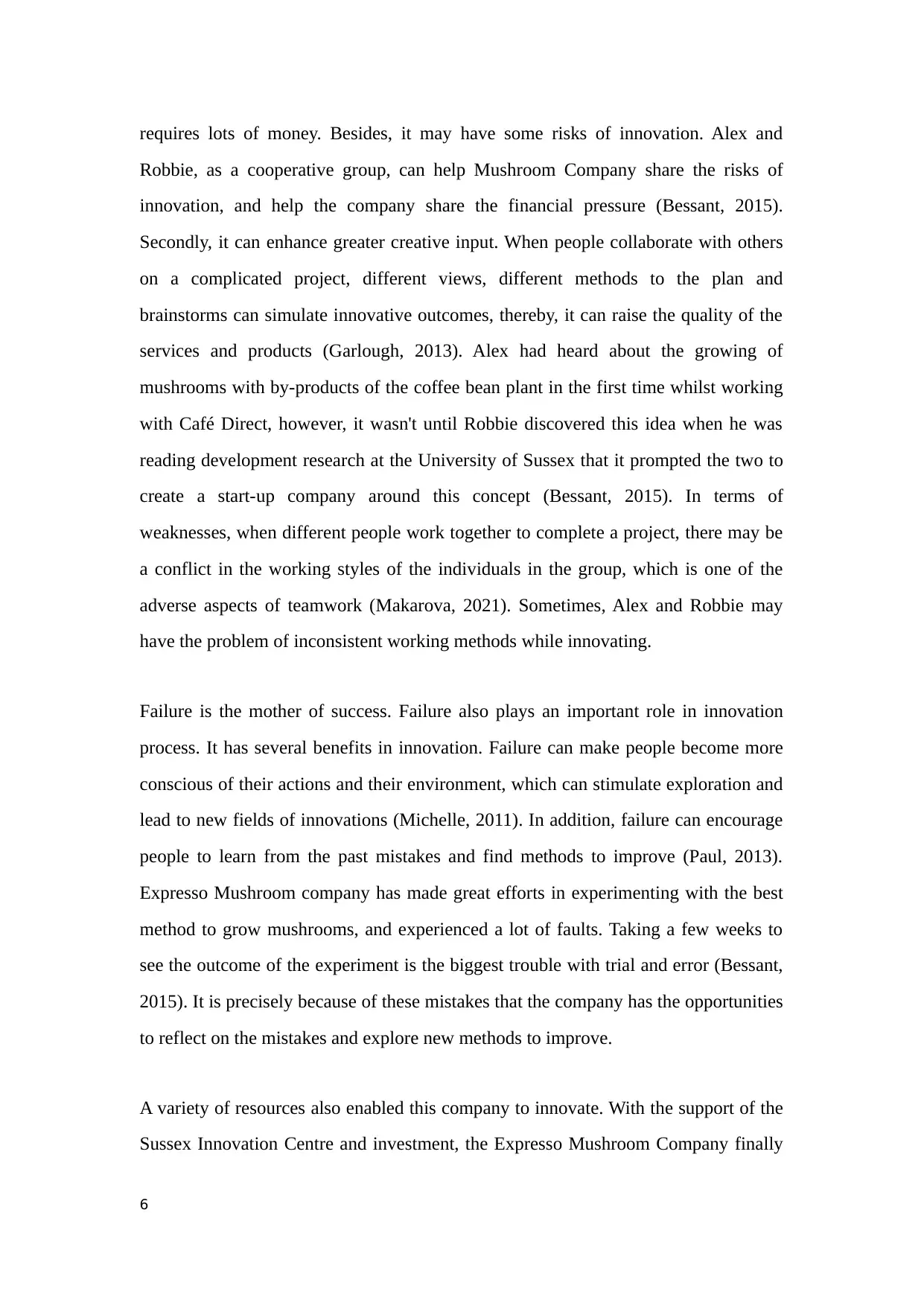
requires lots of money. Besides, it may have some risks of innovation. Alex and
Robbie, as a cooperative group, can help Mushroom Company share the risks of
innovation, and help the company share the financial pressure (Bessant, 2015).
Secondly, it can enhance greater creative input. When people collaborate with others
on a complicated project, different views, different methods to the plan and
brainstorms can simulate innovative outcomes, thereby, it can raise the quality of the
services and products (Garlough, 2013). Alex had heard about the growing of
mushrooms with by-products of the coffee bean plant in the first time whilst working
with Café Direct, however, it wasn't until Robbie discovered this idea when he was
reading development research at the University of Sussex that it prompted the two to
create a start-up company around this concept (Bessant, 2015). In terms of
weaknesses, when different people work together to complete a project, there may be
a conflict in the working styles of the individuals in the group, which is one of the
adverse aspects of teamwork (Makarova, 2021). Sometimes, Alex and Robbie may
have the problem of inconsistent working methods while innovating.
Failure is the mother of success. Failure also plays an important role in innovation
process. It has several benefits in innovation. Failure can make people become more
conscious of their actions and their environment, which can stimulate exploration and
lead to new fields of innovations (Michelle, 2011). In addition, failure can encourage
people to learn from the past mistakes and find methods to improve (Paul, 2013).
Expresso Mushroom company has made great efforts in experimenting with the best
method to grow mushrooms, and experienced a lot of faults. Taking a few weeks to
see the outcome of the experiment is the biggest trouble with trial and error (Bessant,
2015). It is precisely because of these mistakes that the company has the opportunities
to reflect on the mistakes and explore new methods to improve.
A variety of resources also enabled this company to innovate. With the support of the
Sussex Innovation Centre and investment, the Expresso Mushroom Company finally
6
Robbie, as a cooperative group, can help Mushroom Company share the risks of
innovation, and help the company share the financial pressure (Bessant, 2015).
Secondly, it can enhance greater creative input. When people collaborate with others
on a complicated project, different views, different methods to the plan and
brainstorms can simulate innovative outcomes, thereby, it can raise the quality of the
services and products (Garlough, 2013). Alex had heard about the growing of
mushrooms with by-products of the coffee bean plant in the first time whilst working
with Café Direct, however, it wasn't until Robbie discovered this idea when he was
reading development research at the University of Sussex that it prompted the two to
create a start-up company around this concept (Bessant, 2015). In terms of
weaknesses, when different people work together to complete a project, there may be
a conflict in the working styles of the individuals in the group, which is one of the
adverse aspects of teamwork (Makarova, 2021). Sometimes, Alex and Robbie may
have the problem of inconsistent working methods while innovating.
Failure is the mother of success. Failure also plays an important role in innovation
process. It has several benefits in innovation. Failure can make people become more
conscious of their actions and their environment, which can stimulate exploration and
lead to new fields of innovations (Michelle, 2011). In addition, failure can encourage
people to learn from the past mistakes and find methods to improve (Paul, 2013).
Expresso Mushroom company has made great efforts in experimenting with the best
method to grow mushrooms, and experienced a lot of faults. Taking a few weeks to
see the outcome of the experiment is the biggest trouble with trial and error (Bessant,
2015). It is precisely because of these mistakes that the company has the opportunities
to reflect on the mistakes and explore new methods to improve.
A variety of resources also enabled this company to innovate. With the support of the
Sussex Innovation Centre and investment, the Expresso Mushroom Company finally
6
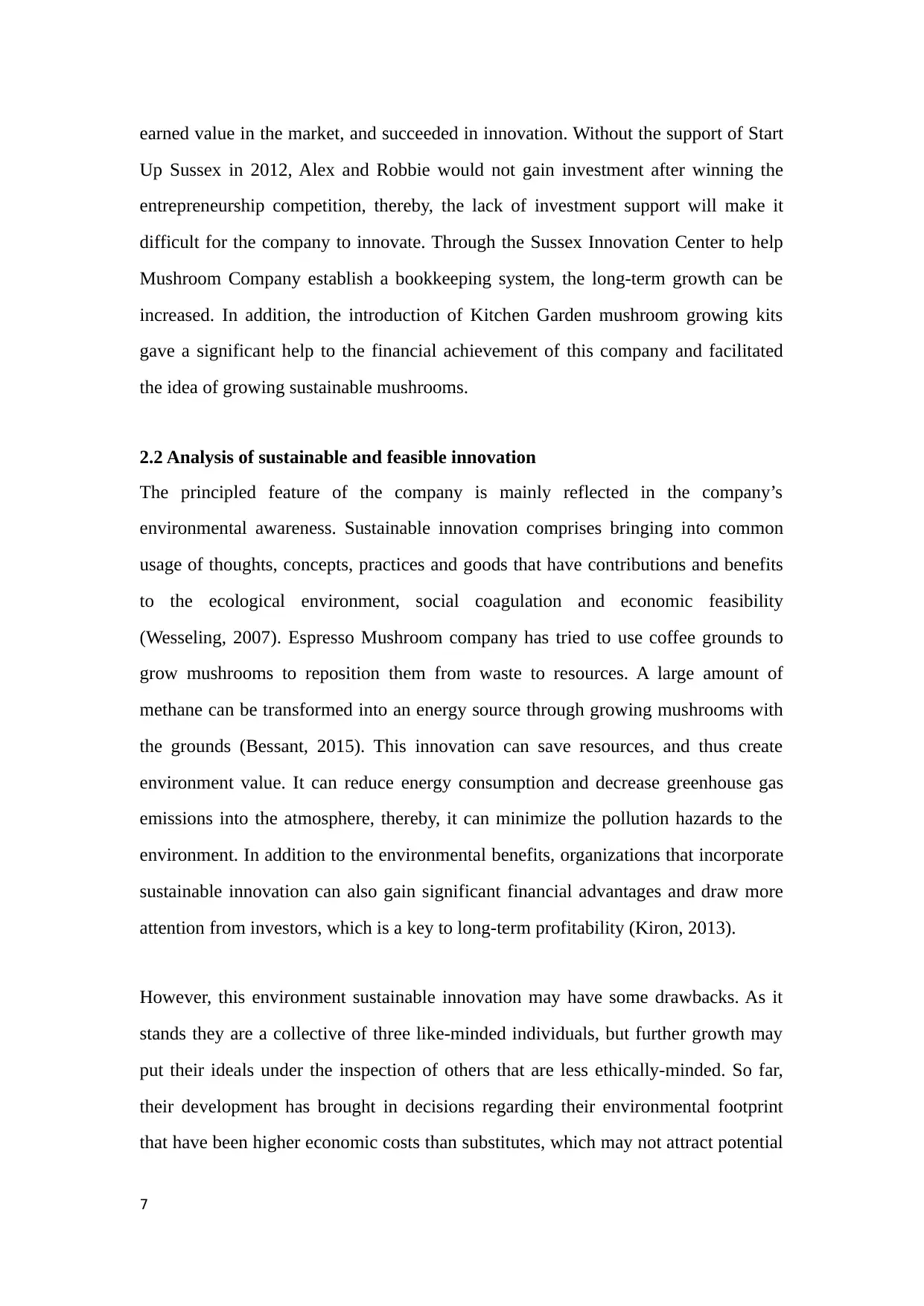
earned value in the market, and succeeded in innovation. Without the support of Start
Up Sussex in 2012, Alex and Robbie would not gain investment after winning the
entrepreneurship competition, thereby, the lack of investment support will make it
difficult for the company to innovate. Through the Sussex Innovation Center to help
Mushroom Company establish a bookkeeping system, the long-term growth can be
increased. In addition, the introduction of Kitchen Garden mushroom growing kits
gave a significant help to the financial achievement of this company and facilitated
the idea of growing sustainable mushrooms.
2.2 Analysis of sustainable and feasible innovation
The principled feature of the company is mainly reflected in the company’s
environmental awareness. Sustainable innovation comprises bringing into common
usage of thoughts, concepts, practices and goods that have contributions and benefits
to the ecological environment, social coagulation and economic feasibility
(Wesseling, 2007). Espresso Mushroom company has tried to use coffee grounds to
grow mushrooms to reposition them from waste to resources. A large amount of
methane can be transformed into an energy source through growing mushrooms with
the grounds (Bessant, 2015). This innovation can save resources, and thus create
environment value. It can reduce energy consumption and decrease greenhouse gas
emissions into the atmosphere, thereby, it can minimize the pollution hazards to the
environment. In addition to the environmental benefits, organizations that incorporate
sustainable innovation can also gain significant financial advantages and draw more
attention from investors, which is a key to long-term profitability (Kiron, 2013).
However, this environment sustainable innovation may have some drawbacks. As it
stands they are a collective of three like-minded individuals, but further growth may
put their ideals under the inspection of others that are less ethically-minded. So far,
their development has brought in decisions regarding their environmental footprint
that have been higher economic costs than substitutes, which may not attract potential
7
Up Sussex in 2012, Alex and Robbie would not gain investment after winning the
entrepreneurship competition, thereby, the lack of investment support will make it
difficult for the company to innovate. Through the Sussex Innovation Center to help
Mushroom Company establish a bookkeeping system, the long-term growth can be
increased. In addition, the introduction of Kitchen Garden mushroom growing kits
gave a significant help to the financial achievement of this company and facilitated
the idea of growing sustainable mushrooms.
2.2 Analysis of sustainable and feasible innovation
The principled feature of the company is mainly reflected in the company’s
environmental awareness. Sustainable innovation comprises bringing into common
usage of thoughts, concepts, practices and goods that have contributions and benefits
to the ecological environment, social coagulation and economic feasibility
(Wesseling, 2007). Espresso Mushroom company has tried to use coffee grounds to
grow mushrooms to reposition them from waste to resources. A large amount of
methane can be transformed into an energy source through growing mushrooms with
the grounds (Bessant, 2015). This innovation can save resources, and thus create
environment value. It can reduce energy consumption and decrease greenhouse gas
emissions into the atmosphere, thereby, it can minimize the pollution hazards to the
environment. In addition to the environmental benefits, organizations that incorporate
sustainable innovation can also gain significant financial advantages and draw more
attention from investors, which is a key to long-term profitability (Kiron, 2013).
However, this environment sustainable innovation may have some drawbacks. As it
stands they are a collective of three like-minded individuals, but further growth may
put their ideals under the inspection of others that are less ethically-minded. So far,
their development has brought in decisions regarding their environmental footprint
that have been higher economic costs than substitutes, which may not attract potential
7
Paraphrase This Document
Need a fresh take? Get an instant paraphrase of this document with our AI Paraphraser
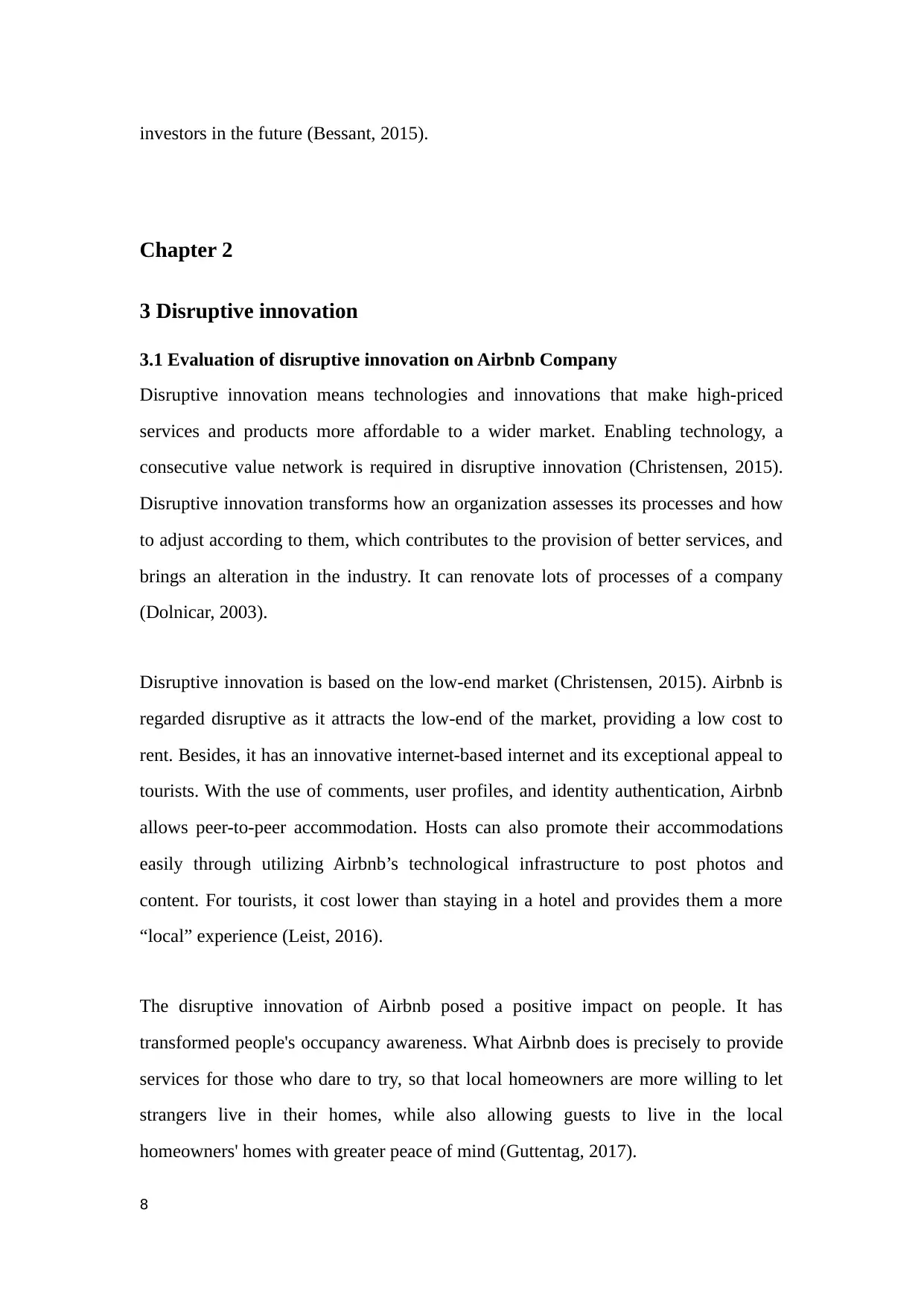
investors in the future (Bessant, 2015).
Chapter 2
3 Disruptive innovation
3.1 Evaluation of disruptive innovation on Airbnb Company
Disruptive innovation means technologies and innovations that make high-priced
services and products more affordable to a wider market. Enabling technology, a
consecutive value network is required in disruptive innovation (Christensen, 2015).
Disruptive innovation transforms how an organization assesses its processes and how
to adjust according to them, which contributes to the provision of better services, and
brings an alteration in the industry. It can renovate lots of processes of a company
(Dolnicar, 2003).
Disruptive innovation is based on the low-end market (Christensen, 2015). Airbnb is
regarded disruptive as it attracts the low-end of the market, providing a low cost to
rent. Besides, it has an innovative internet-based internet and its exceptional appeal to
tourists. With the use of comments, user profiles, and identity authentication, Airbnb
allows peer-to-peer accommodation. Hosts can also promote their accommodations
easily through utilizing Airbnb’s technological infrastructure to post photos and
content. For tourists, it cost lower than staying in a hotel and provides them a more
“local” experience (Leist, 2016).
The disruptive innovation of Airbnb posed a positive impact on people. It has
transformed people's occupancy awareness. What Airbnb does is precisely to provide
services for those who dare to try, so that local homeowners are more willing to let
strangers live in their homes, while also allowing guests to live in the local
homeowners' homes with greater peace of mind (Guttentag, 2017).
8
Chapter 2
3 Disruptive innovation
3.1 Evaluation of disruptive innovation on Airbnb Company
Disruptive innovation means technologies and innovations that make high-priced
services and products more affordable to a wider market. Enabling technology, a
consecutive value network is required in disruptive innovation (Christensen, 2015).
Disruptive innovation transforms how an organization assesses its processes and how
to adjust according to them, which contributes to the provision of better services, and
brings an alteration in the industry. It can renovate lots of processes of a company
(Dolnicar, 2003).
Disruptive innovation is based on the low-end market (Christensen, 2015). Airbnb is
regarded disruptive as it attracts the low-end of the market, providing a low cost to
rent. Besides, it has an innovative internet-based internet and its exceptional appeal to
tourists. With the use of comments, user profiles, and identity authentication, Airbnb
allows peer-to-peer accommodation. Hosts can also promote their accommodations
easily through utilizing Airbnb’s technological infrastructure to post photos and
content. For tourists, it cost lower than staying in a hotel and provides them a more
“local” experience (Leist, 2016).
The disruptive innovation of Airbnb posed a positive impact on people. It has
transformed people's occupancy awareness. What Airbnb does is precisely to provide
services for those who dare to try, so that local homeowners are more willing to let
strangers live in their homes, while also allowing guests to live in the local
homeowners' homes with greater peace of mind (Guttentag, 2017).
8
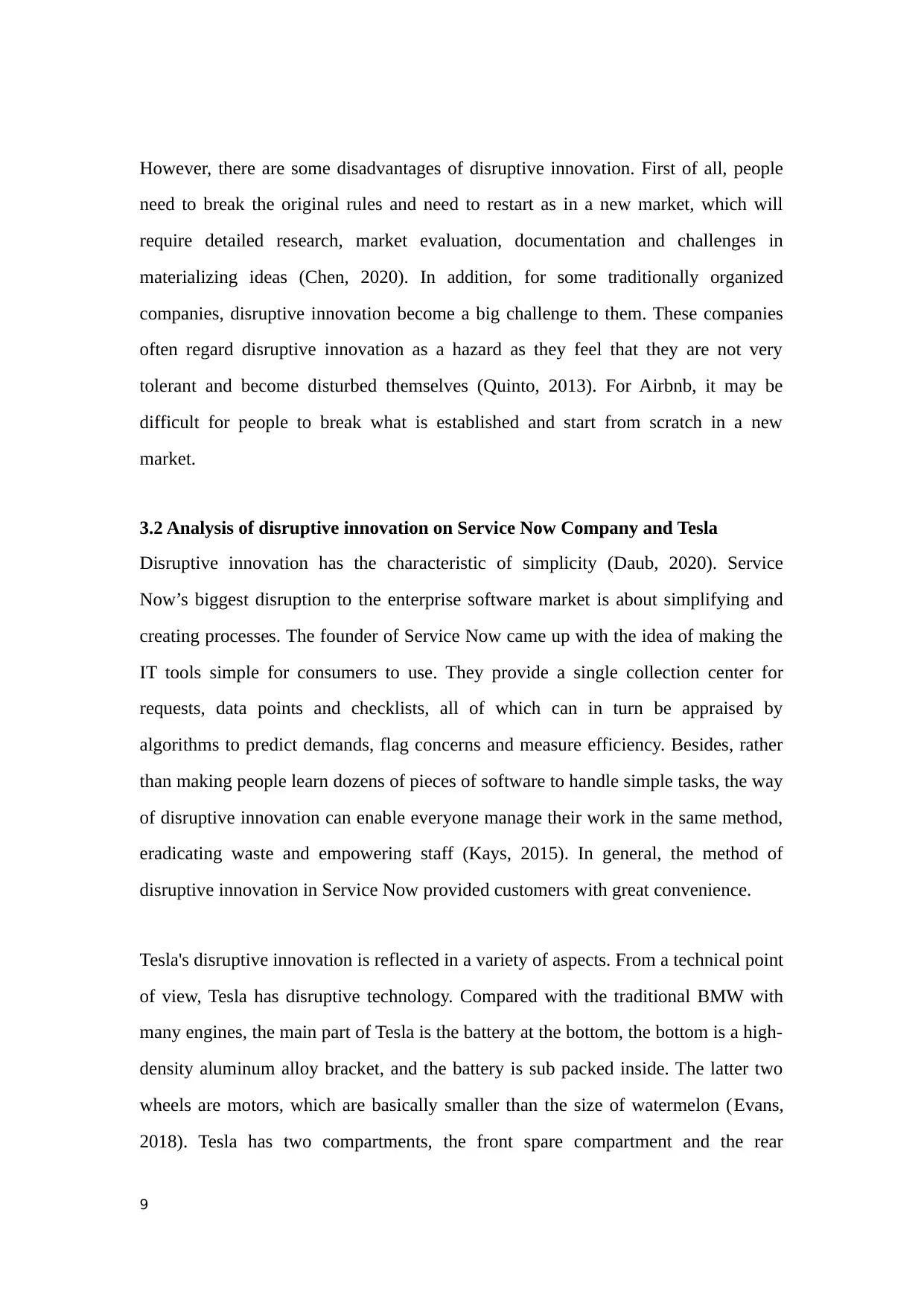
However, there are some disadvantages of disruptive innovation. First of all, people
need to break the original rules and need to restart as in a new market, which will
require detailed research, market evaluation, documentation and challenges in
materializing ideas (Chen, 2020). In addition, for some traditionally organized
companies, disruptive innovation become a big challenge to them. These companies
often regard disruptive innovation as a hazard as they feel that they are not very
tolerant and become disturbed themselves (Quinto, 2013). For Airbnb, it may be
difficult for people to break what is established and start from scratch in a new
market.
3.2 Analysis of disruptive innovation on Service Now Company and Tesla
Disruptive innovation has the characteristic of simplicity (Daub, 2020). Service
Now’s biggest disruption to the enterprise software market is about simplifying and
creating processes. The founder of Service Now came up with the idea of making the
IT tools simple for consumers to use. They provide a single collection center for
requests, data points and checklists, all of which can in turn be appraised by
algorithms to predict demands, flag concerns and measure efficiency. Besides, rather
than making people learn dozens of pieces of software to handle simple tasks, the way
of disruptive innovation can enable everyone manage their work in the same method,
eradicating waste and empowering staff (Kays, 2015). In general, the method of
disruptive innovation in Service Now provided customers with great convenience.
Tesla's disruptive innovation is reflected in a variety of aspects. From a technical point
of view, Tesla has disruptive technology. Compared with the traditional BMW with
many engines, the main part of Tesla is the battery at the bottom, the bottom is a high-
density aluminum alloy bracket, and the battery is sub packed inside. The latter two
wheels are motors, which are basically smaller than the size of watermelon (Evans,
2018). Tesla has two compartments, the front spare compartment and the rear
9
need to break the original rules and need to restart as in a new market, which will
require detailed research, market evaluation, documentation and challenges in
materializing ideas (Chen, 2020). In addition, for some traditionally organized
companies, disruptive innovation become a big challenge to them. These companies
often regard disruptive innovation as a hazard as they feel that they are not very
tolerant and become disturbed themselves (Quinto, 2013). For Airbnb, it may be
difficult for people to break what is established and start from scratch in a new
market.
3.2 Analysis of disruptive innovation on Service Now Company and Tesla
Disruptive innovation has the characteristic of simplicity (Daub, 2020). Service
Now’s biggest disruption to the enterprise software market is about simplifying and
creating processes. The founder of Service Now came up with the idea of making the
IT tools simple for consumers to use. They provide a single collection center for
requests, data points and checklists, all of which can in turn be appraised by
algorithms to predict demands, flag concerns and measure efficiency. Besides, rather
than making people learn dozens of pieces of software to handle simple tasks, the way
of disruptive innovation can enable everyone manage their work in the same method,
eradicating waste and empowering staff (Kays, 2015). In general, the method of
disruptive innovation in Service Now provided customers with great convenience.
Tesla's disruptive innovation is reflected in a variety of aspects. From a technical point
of view, Tesla has disruptive technology. Compared with the traditional BMW with
many engines, the main part of Tesla is the battery at the bottom, the bottom is a high-
density aluminum alloy bracket, and the battery is sub packed inside. The latter two
wheels are motors, which are basically smaller than the size of watermelon (Evans,
2018). Tesla has two compartments, the front spare compartment and the rear
9
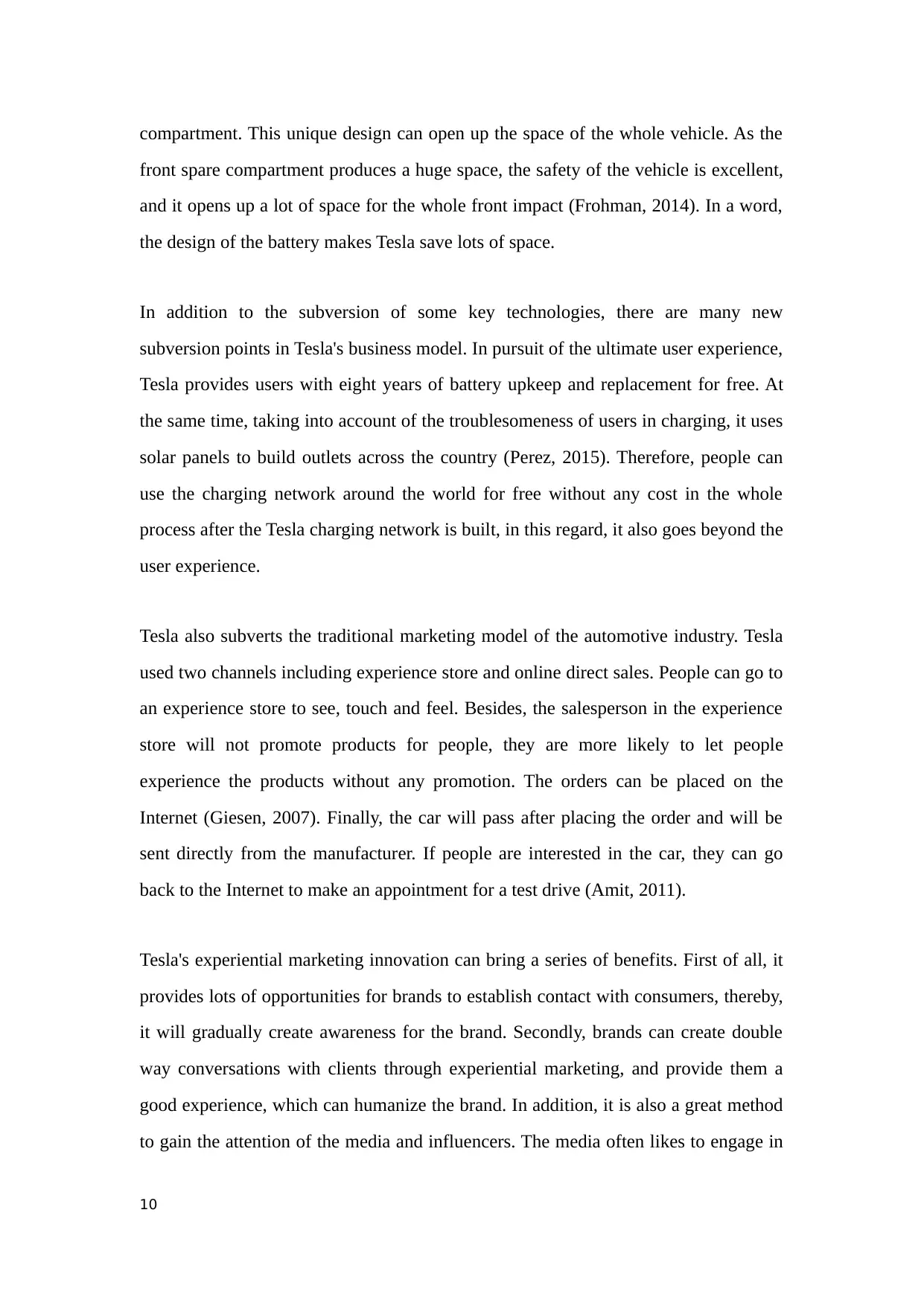
compartment. This unique design can open up the space of the whole vehicle. As the
front spare compartment produces a huge space, the safety of the vehicle is excellent,
and it opens up a lot of space for the whole front impact (Frohman, 2014). In a word,
the design of the battery makes Tesla save lots of space.
In addition to the subversion of some key technologies, there are many new
subversion points in Tesla's business model. In pursuit of the ultimate user experience,
Tesla provides users with eight years of battery upkeep and replacement for free. At
the same time, taking into account of the troublesomeness of users in charging, it uses
solar panels to build outlets across the country (Perez, 2015). Therefore, people can
use the charging network around the world for free without any cost in the whole
process after the Tesla charging network is built, in this regard, it also goes beyond the
user experience.
Tesla also subverts the traditional marketing model of the automotive industry. Tesla
used two channels including experience store and online direct sales. People can go to
an experience store to see, touch and feel. Besides, the salesperson in the experience
store will not promote products for people, they are more likely to let people
experience the products without any promotion. The orders can be placed on the
Internet (Giesen, 2007). Finally, the car will pass after placing the order and will be
sent directly from the manufacturer. If people are interested in the car, they can go
back to the Internet to make an appointment for a test drive (Amit, 2011).
Tesla's experiential marketing innovation can bring a series of benefits. First of all, it
provides lots of opportunities for brands to establish contact with consumers, thereby,
it will gradually create awareness for the brand. Secondly, brands can create double
way conversations with clients through experiential marketing, and provide them a
good experience, which can humanize the brand. In addition, it is also a great method
to gain the attention of the media and influencers. The media often likes to engage in
10
front spare compartment produces a huge space, the safety of the vehicle is excellent,
and it opens up a lot of space for the whole front impact (Frohman, 2014). In a word,
the design of the battery makes Tesla save lots of space.
In addition to the subversion of some key technologies, there are many new
subversion points in Tesla's business model. In pursuit of the ultimate user experience,
Tesla provides users with eight years of battery upkeep and replacement for free. At
the same time, taking into account of the troublesomeness of users in charging, it uses
solar panels to build outlets across the country (Perez, 2015). Therefore, people can
use the charging network around the world for free without any cost in the whole
process after the Tesla charging network is built, in this regard, it also goes beyond the
user experience.
Tesla also subverts the traditional marketing model of the automotive industry. Tesla
used two channels including experience store and online direct sales. People can go to
an experience store to see, touch and feel. Besides, the salesperson in the experience
store will not promote products for people, they are more likely to let people
experience the products without any promotion. The orders can be placed on the
Internet (Giesen, 2007). Finally, the car will pass after placing the order and will be
sent directly from the manufacturer. If people are interested in the car, they can go
back to the Internet to make an appointment for a test drive (Amit, 2011).
Tesla's experiential marketing innovation can bring a series of benefits. First of all, it
provides lots of opportunities for brands to establish contact with consumers, thereby,
it will gradually create awareness for the brand. Secondly, brands can create double
way conversations with clients through experiential marketing, and provide them a
good experience, which can humanize the brand. In addition, it is also a great method
to gain the attention of the media and influencers. The media often likes to engage in
10
Secure Best Marks with AI Grader
Need help grading? Try our AI Grader for instant feedback on your assignments.
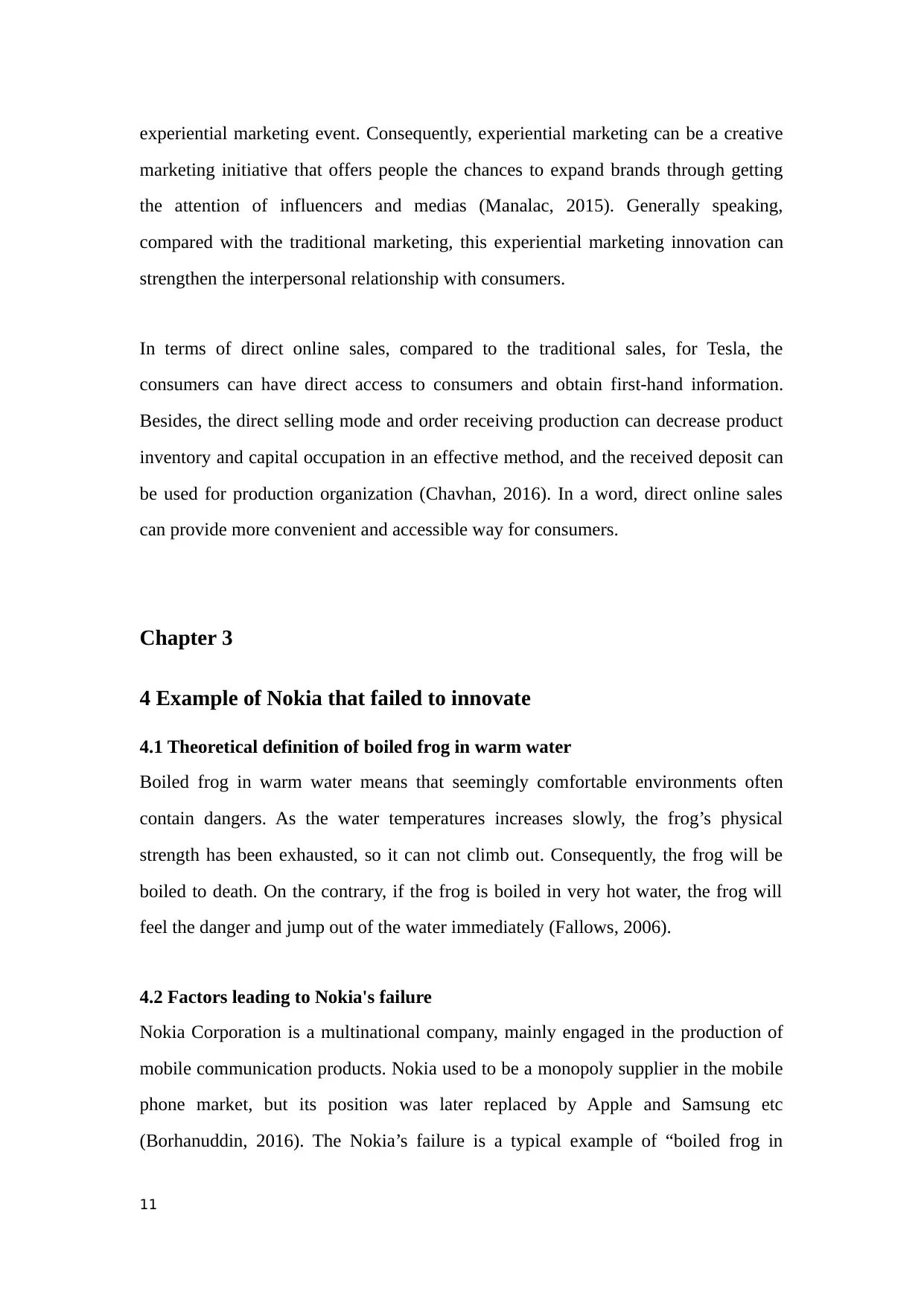
experiential marketing event. Consequently, experiential marketing can be a creative
marketing initiative that offers people the chances to expand brands through getting
the attention of influencers and medias (Manalac, 2015). Generally speaking,
compared with the traditional marketing, this experiential marketing innovation can
strengthen the interpersonal relationship with consumers.
In terms of direct online sales, compared to the traditional sales, for Tesla, the
consumers can have direct access to consumers and obtain first-hand information.
Besides, the direct selling mode and order receiving production can decrease product
inventory and capital occupation in an effective method, and the received deposit can
be used for production organization (Chavhan, 2016). In a word, direct online sales
can provide more convenient and accessible way for consumers.
Chapter 3
4 Example of Nokia that failed to innovate
4.1 Theoretical definition of boiled frog in warm water
Boiled frog in warm water means that seemingly comfortable environments often
contain dangers. As the water temperatures increases slowly, the frog’s physical
strength has been exhausted, so it can not climb out. Consequently, the frog will be
boiled to death. On the contrary, if the frog is boiled in very hot water, the frog will
feel the danger and jump out of the water immediately (Fallows, 2006).
4.2 Factors leading to Nokia's failure
Nokia Corporation is a multinational company, mainly engaged in the production of
mobile communication products. Nokia used to be a monopoly supplier in the mobile
phone market, but its position was later replaced by Apple and Samsung etc
(Borhanuddin, 2016). The Nokia’s failure is a typical example of “boiled frog in
11
marketing initiative that offers people the chances to expand brands through getting
the attention of influencers and medias (Manalac, 2015). Generally speaking,
compared with the traditional marketing, this experiential marketing innovation can
strengthen the interpersonal relationship with consumers.
In terms of direct online sales, compared to the traditional sales, for Tesla, the
consumers can have direct access to consumers and obtain first-hand information.
Besides, the direct selling mode and order receiving production can decrease product
inventory and capital occupation in an effective method, and the received deposit can
be used for production organization (Chavhan, 2016). In a word, direct online sales
can provide more convenient and accessible way for consumers.
Chapter 3
4 Example of Nokia that failed to innovate
4.1 Theoretical definition of boiled frog in warm water
Boiled frog in warm water means that seemingly comfortable environments often
contain dangers. As the water temperatures increases slowly, the frog’s physical
strength has been exhausted, so it can not climb out. Consequently, the frog will be
boiled to death. On the contrary, if the frog is boiled in very hot water, the frog will
feel the danger and jump out of the water immediately (Fallows, 2006).
4.2 Factors leading to Nokia's failure
Nokia Corporation is a multinational company, mainly engaged in the production of
mobile communication products. Nokia used to be a monopoly supplier in the mobile
phone market, but its position was later replaced by Apple and Samsung etc
(Borhanuddin, 2016). The Nokia’s failure is a typical example of “boiled frog in
11
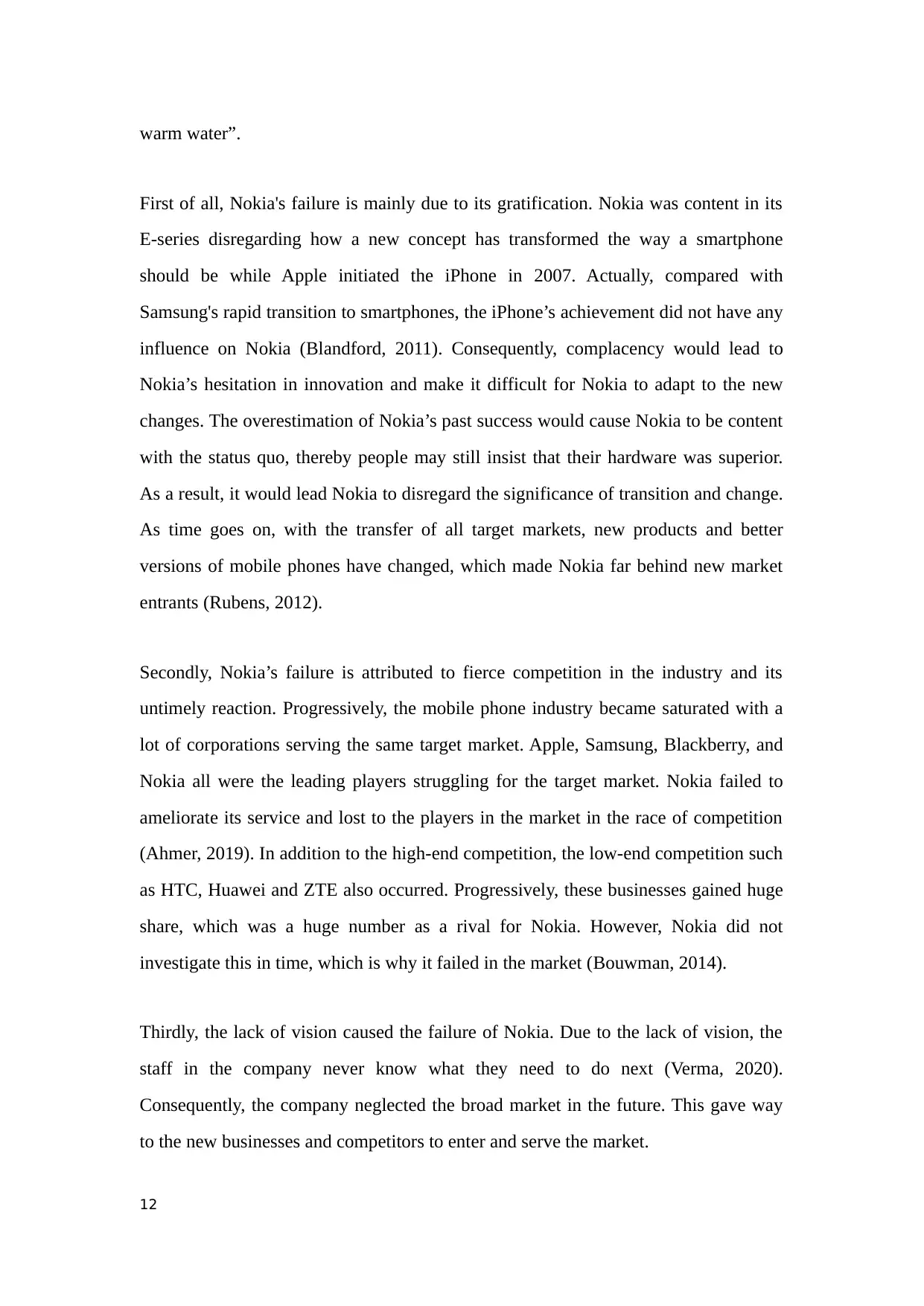
warm water”.
First of all, Nokia's failure is mainly due to its gratification. Nokia was content in its
E-series disregarding how a new concept has transformed the way a smartphone
should be while Apple initiated the iPhone in 2007. Actually, compared with
Samsung's rapid transition to smartphones, the iPhone’s achievement did not have any
influence on Nokia (Blandford, 2011). Consequently, complacency would lead to
Nokia’s hesitation in innovation and make it difficult for Nokia to adapt to the new
changes. The overestimation of Nokia’s past success would cause Nokia to be content
with the status quo, thereby people may still insist that their hardware was superior.
As a result, it would lead Nokia to disregard the significance of transition and change.
As time goes on, with the transfer of all target markets, new products and better
versions of mobile phones have changed, which made Nokia far behind new market
entrants (Rubens, 2012).
Secondly, Nokia’s failure is attributed to fierce competition in the industry and its
untimely reaction. Progressively, the mobile phone industry became saturated with a
lot of corporations serving the same target market. Apple, Samsung, Blackberry, and
Nokia all were the leading players struggling for the target market. Nokia failed to
ameliorate its service and lost to the players in the market in the race of competition
(Ahmer, 2019). In addition to the high-end competition, the low-end competition such
as HTC, Huawei and ZTE also occurred. Progressively, these businesses gained huge
share, which was a huge number as a rival for Nokia. However, Nokia did not
investigate this in time, which is why it failed in the market (Bouwman, 2014).
Thirdly, the lack of vision caused the failure of Nokia. Due to the lack of vision, the
staff in the company never know what they need to do next (Verma, 2020).
Consequently, the company neglected the broad market in the future. This gave way
to the new businesses and competitors to enter and serve the market.
12
First of all, Nokia's failure is mainly due to its gratification. Nokia was content in its
E-series disregarding how a new concept has transformed the way a smartphone
should be while Apple initiated the iPhone in 2007. Actually, compared with
Samsung's rapid transition to smartphones, the iPhone’s achievement did not have any
influence on Nokia (Blandford, 2011). Consequently, complacency would lead to
Nokia’s hesitation in innovation and make it difficult for Nokia to adapt to the new
changes. The overestimation of Nokia’s past success would cause Nokia to be content
with the status quo, thereby people may still insist that their hardware was superior.
As a result, it would lead Nokia to disregard the significance of transition and change.
As time goes on, with the transfer of all target markets, new products and better
versions of mobile phones have changed, which made Nokia far behind new market
entrants (Rubens, 2012).
Secondly, Nokia’s failure is attributed to fierce competition in the industry and its
untimely reaction. Progressively, the mobile phone industry became saturated with a
lot of corporations serving the same target market. Apple, Samsung, Blackberry, and
Nokia all were the leading players struggling for the target market. Nokia failed to
ameliorate its service and lost to the players in the market in the race of competition
(Ahmer, 2019). In addition to the high-end competition, the low-end competition such
as HTC, Huawei and ZTE also occurred. Progressively, these businesses gained huge
share, which was a huge number as a rival for Nokia. However, Nokia did not
investigate this in time, which is why it failed in the market (Bouwman, 2014).
Thirdly, the lack of vision caused the failure of Nokia. Due to the lack of vision, the
staff in the company never know what they need to do next (Verma, 2020).
Consequently, the company neglected the broad market in the future. This gave way
to the new businesses and competitors to enter and serve the market.
12
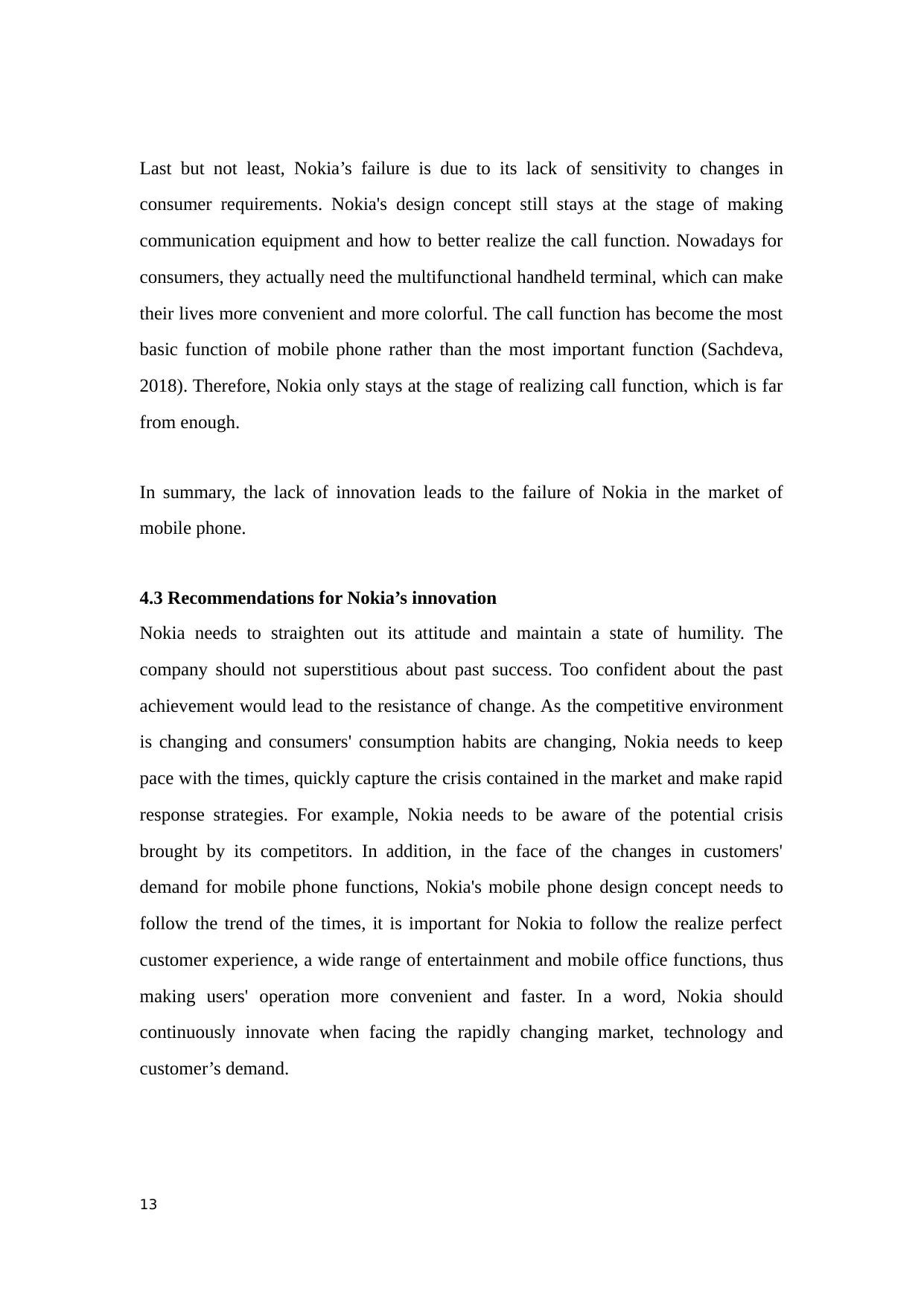
Last but not least, Nokia’s failure is due to its lack of sensitivity to changes in
consumer requirements. Nokia's design concept still stays at the stage of making
communication equipment and how to better realize the call function. Nowadays for
consumers, they actually need the multifunctional handheld terminal, which can make
their lives more convenient and more colorful. The call function has become the most
basic function of mobile phone rather than the most important function (Sachdeva,
2018). Therefore, Nokia only stays at the stage of realizing call function, which is far
from enough.
In summary, the lack of innovation leads to the failure of Nokia in the market of
mobile phone.
4.3 Recommendations for Nokia’s innovation
Nokia needs to straighten out its attitude and maintain a state of humility. The
company should not superstitious about past success. Too confident about the past
achievement would lead to the resistance of change. As the competitive environment
is changing and consumers' consumption habits are changing, Nokia needs to keep
pace with the times, quickly capture the crisis contained in the market and make rapid
response strategies. For example, Nokia needs to be aware of the potential crisis
brought by its competitors. In addition, in the face of the changes in customers'
demand for mobile phone functions, Nokia's mobile phone design concept needs to
follow the trend of the times, it is important for Nokia to follow the realize perfect
customer experience, a wide range of entertainment and mobile office functions, thus
making users' operation more convenient and faster. In a word, Nokia should
continuously innovate when facing the rapidly changing market, technology and
customer’s demand.
13
consumer requirements. Nokia's design concept still stays at the stage of making
communication equipment and how to better realize the call function. Nowadays for
consumers, they actually need the multifunctional handheld terminal, which can make
their lives more convenient and more colorful. The call function has become the most
basic function of mobile phone rather than the most important function (Sachdeva,
2018). Therefore, Nokia only stays at the stage of realizing call function, which is far
from enough.
In summary, the lack of innovation leads to the failure of Nokia in the market of
mobile phone.
4.3 Recommendations for Nokia’s innovation
Nokia needs to straighten out its attitude and maintain a state of humility. The
company should not superstitious about past success. Too confident about the past
achievement would lead to the resistance of change. As the competitive environment
is changing and consumers' consumption habits are changing, Nokia needs to keep
pace with the times, quickly capture the crisis contained in the market and make rapid
response strategies. For example, Nokia needs to be aware of the potential crisis
brought by its competitors. In addition, in the face of the changes in customers'
demand for mobile phone functions, Nokia's mobile phone design concept needs to
follow the trend of the times, it is important for Nokia to follow the realize perfect
customer experience, a wide range of entertainment and mobile office functions, thus
making users' operation more convenient and faster. In a word, Nokia should
continuously innovate when facing the rapidly changing market, technology and
customer’s demand.
13
Paraphrase This Document
Need a fresh take? Get an instant paraphrase of this document with our AI Paraphraser
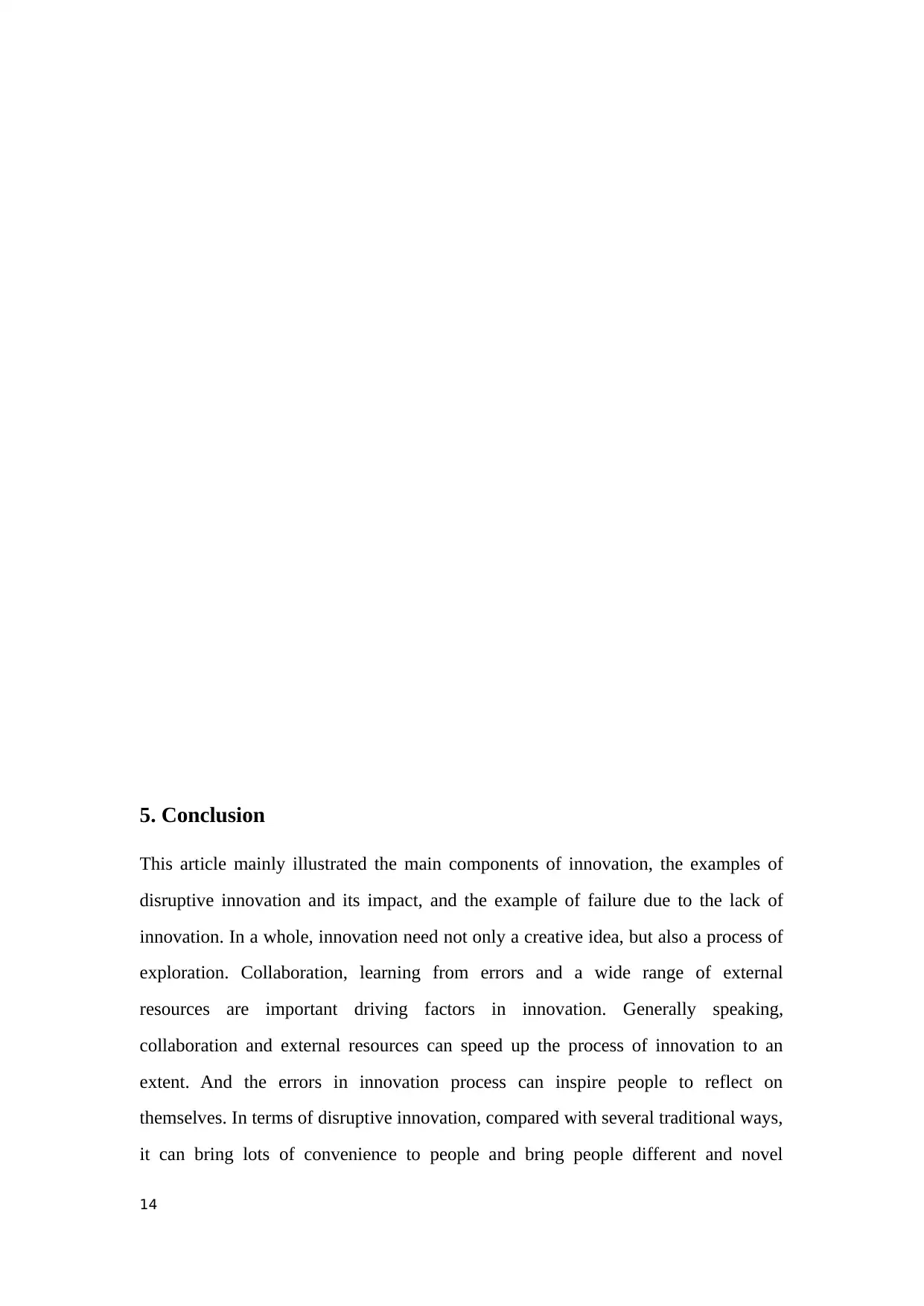
5. Conclusion
This article mainly illustrated the main components of innovation, the examples of
disruptive innovation and its impact, and the example of failure due to the lack of
innovation. In a whole, innovation need not only a creative idea, but also a process of
exploration. Collaboration, learning from errors and a wide range of external
resources are important driving factors in innovation. Generally speaking,
collaboration and external resources can speed up the process of innovation to an
extent. And the errors in innovation process can inspire people to reflect on
themselves. In terms of disruptive innovation, compared with several traditional ways,
it can bring lots of convenience to people and bring people different and novel
14
This article mainly illustrated the main components of innovation, the examples of
disruptive innovation and its impact, and the example of failure due to the lack of
innovation. In a whole, innovation need not only a creative idea, but also a process of
exploration. Collaboration, learning from errors and a wide range of external
resources are important driving factors in innovation. Generally speaking,
collaboration and external resources can speed up the process of innovation to an
extent. And the errors in innovation process can inspire people to reflect on
themselves. In terms of disruptive innovation, compared with several traditional ways,
it can bring lots of convenience to people and bring people different and novel
14
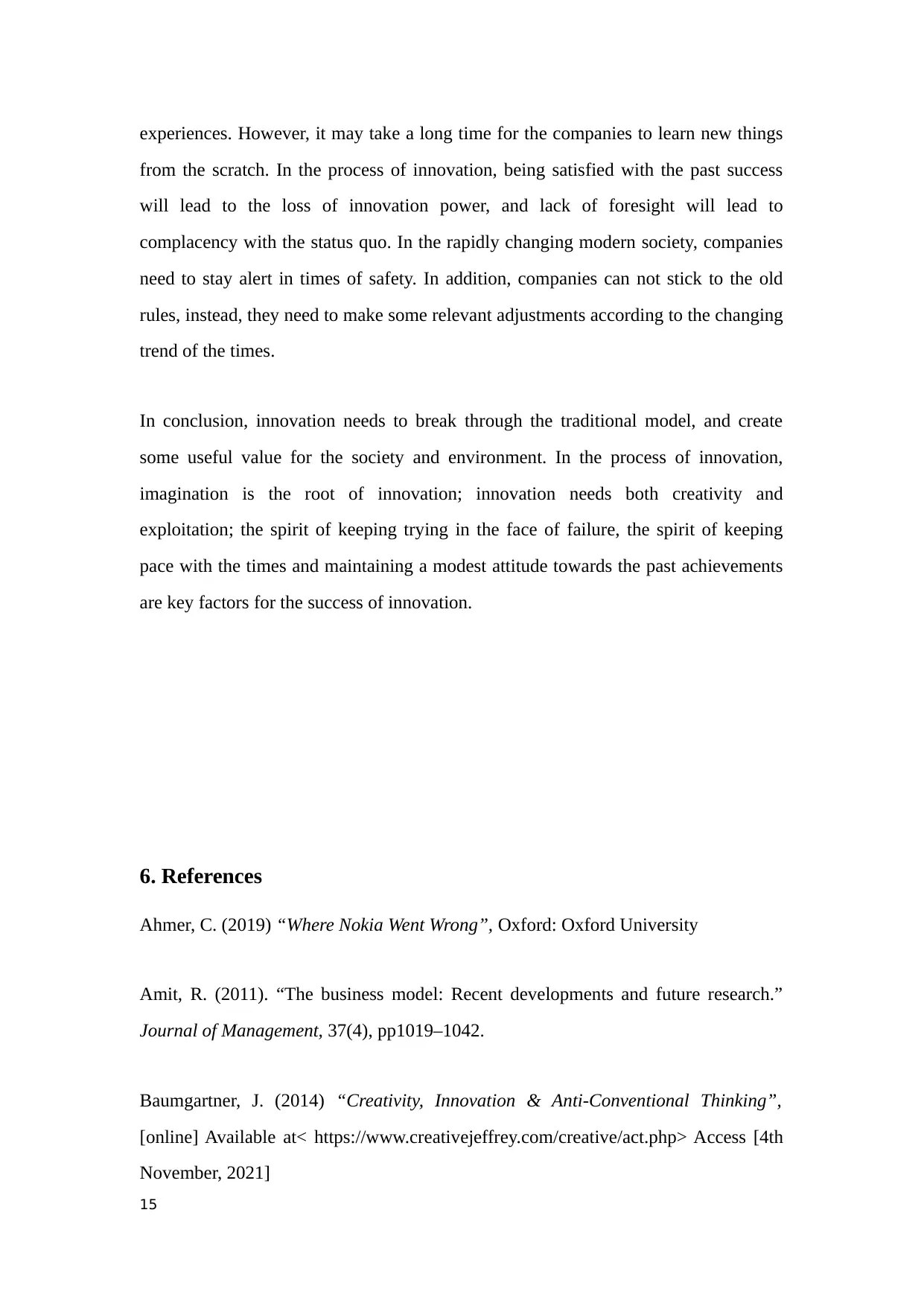
experiences. However, it may take a long time for the companies to learn new things
from the scratch. In the process of innovation, being satisfied with the past success
will lead to the loss of innovation power, and lack of foresight will lead to
complacency with the status quo. In the rapidly changing modern society, companies
need to stay alert in times of safety. In addition, companies can not stick to the old
rules, instead, they need to make some relevant adjustments according to the changing
trend of the times.
In conclusion, innovation needs to break through the traditional model, and create
some useful value for the society and environment. In the process of innovation,
imagination is the root of innovation; innovation needs both creativity and
exploitation; the spirit of keeping trying in the face of failure, the spirit of keeping
pace with the times and maintaining a modest attitude towards the past achievements
are key factors for the success of innovation.
6. References
Ahmer, C. (2019) “Where Nokia Went Wrong”, Oxford: Oxford University
Amit, R. (2011). “The business model: Recent developments and future research.”
Journal of Management, 37(4), pp1019–1042.
Baumgartner, J. (2014) “Creativity, Innovation & Anti-Conventional Thinking”,
[online] Available at< https://www.creativejeffrey.com/creative/act.php> Access [4th
November, 2021]
15
from the scratch. In the process of innovation, being satisfied with the past success
will lead to the loss of innovation power, and lack of foresight will lead to
complacency with the status quo. In the rapidly changing modern society, companies
need to stay alert in times of safety. In addition, companies can not stick to the old
rules, instead, they need to make some relevant adjustments according to the changing
trend of the times.
In conclusion, innovation needs to break through the traditional model, and create
some useful value for the society and environment. In the process of innovation,
imagination is the root of innovation; innovation needs both creativity and
exploitation; the spirit of keeping trying in the face of failure, the spirit of keeping
pace with the times and maintaining a modest attitude towards the past achievements
are key factors for the success of innovation.
6. References
Ahmer, C. (2019) “Where Nokia Went Wrong”, Oxford: Oxford University
Amit, R. (2011). “The business model: Recent developments and future research.”
Journal of Management, 37(4), pp1019–1042.
Baumgartner, J. (2014) “Creativity, Innovation & Anti-Conventional Thinking”,
[online] Available at< https://www.creativejeffrey.com/creative/act.php> Access [4th
November, 2021]
15
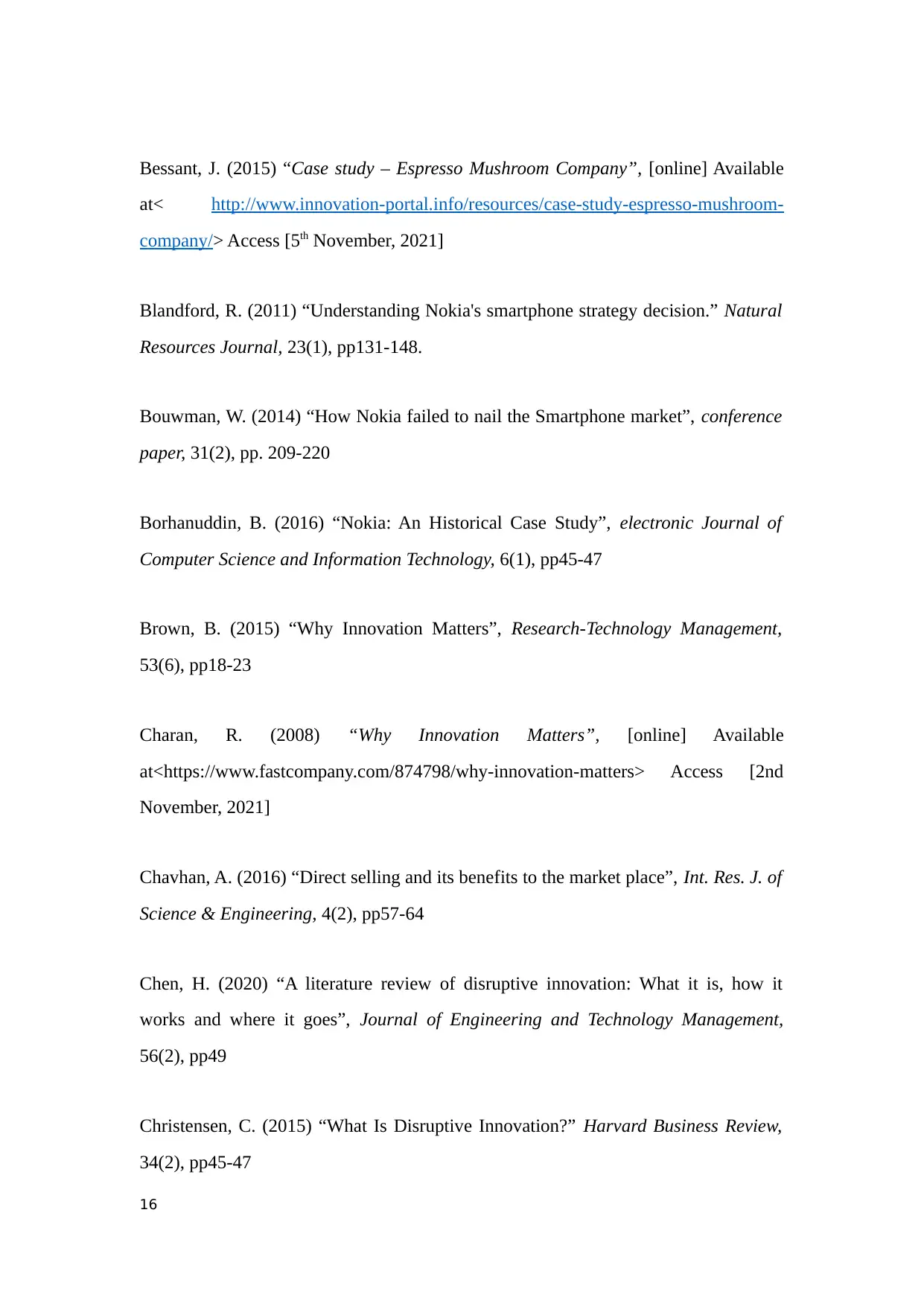
Bessant, J. (2015) “Case study – Espresso Mushroom Company”, [online] Available
at< http://www.innovation-portal.info/resources/case-study-espresso-mushroom-
company/> Access [5th November, 2021]
Blandford, R. (2011) “Understanding Nokia's smartphone strategy decision.” Natural
Resources Journal, 23(1), pp131-148.
Bouwman, W. (2014) “How Nokia failed to nail the Smartphone market”, conference
paper, 31(2), pp. 209-220
Borhanuddin, B. (2016) “Nokia: An Historical Case Study”, electronic Journal of
Computer Science and Information Technology, 6(1), pp45-47
Brown, B. (2015) “Why Innovation Matters”, Research-Technology Management,
53(6), pp18-23
Charan, R. (2008) “Why Innovation Matters”, [online] Available
at<https://www.fastcompany.com/874798/why-innovation-matters> Access [2nd
November, 2021]
Chavhan, A. (2016) “Direct selling and its benefits to the market place”, Int. Res. J. of
Science & Engineering, 4(2), pp57-64
Chen, H. (2020) “A literature review of disruptive innovation: What it is, how it
works and where it goes”, Journal of Engineering and Technology Management,
56(2), pp49
Christensen, C. (2015) “What Is Disruptive Innovation?” Harvard Business Review,
34(2), pp45-47
16
at< http://www.innovation-portal.info/resources/case-study-espresso-mushroom-
company/> Access [5th November, 2021]
Blandford, R. (2011) “Understanding Nokia's smartphone strategy decision.” Natural
Resources Journal, 23(1), pp131-148.
Bouwman, W. (2014) “How Nokia failed to nail the Smartphone market”, conference
paper, 31(2), pp. 209-220
Borhanuddin, B. (2016) “Nokia: An Historical Case Study”, electronic Journal of
Computer Science and Information Technology, 6(1), pp45-47
Brown, B. (2015) “Why Innovation Matters”, Research-Technology Management,
53(6), pp18-23
Charan, R. (2008) “Why Innovation Matters”, [online] Available
at<https://www.fastcompany.com/874798/why-innovation-matters> Access [2nd
November, 2021]
Chavhan, A. (2016) “Direct selling and its benefits to the market place”, Int. Res. J. of
Science & Engineering, 4(2), pp57-64
Chen, H. (2020) “A literature review of disruptive innovation: What it is, how it
works and where it goes”, Journal of Engineering and Technology Management,
56(2), pp49
Christensen, C. (2015) “What Is Disruptive Innovation?” Harvard Business Review,
34(2), pp45-47
16
Secure Best Marks with AI Grader
Need help grading? Try our AI Grader for instant feedback on your assignments.
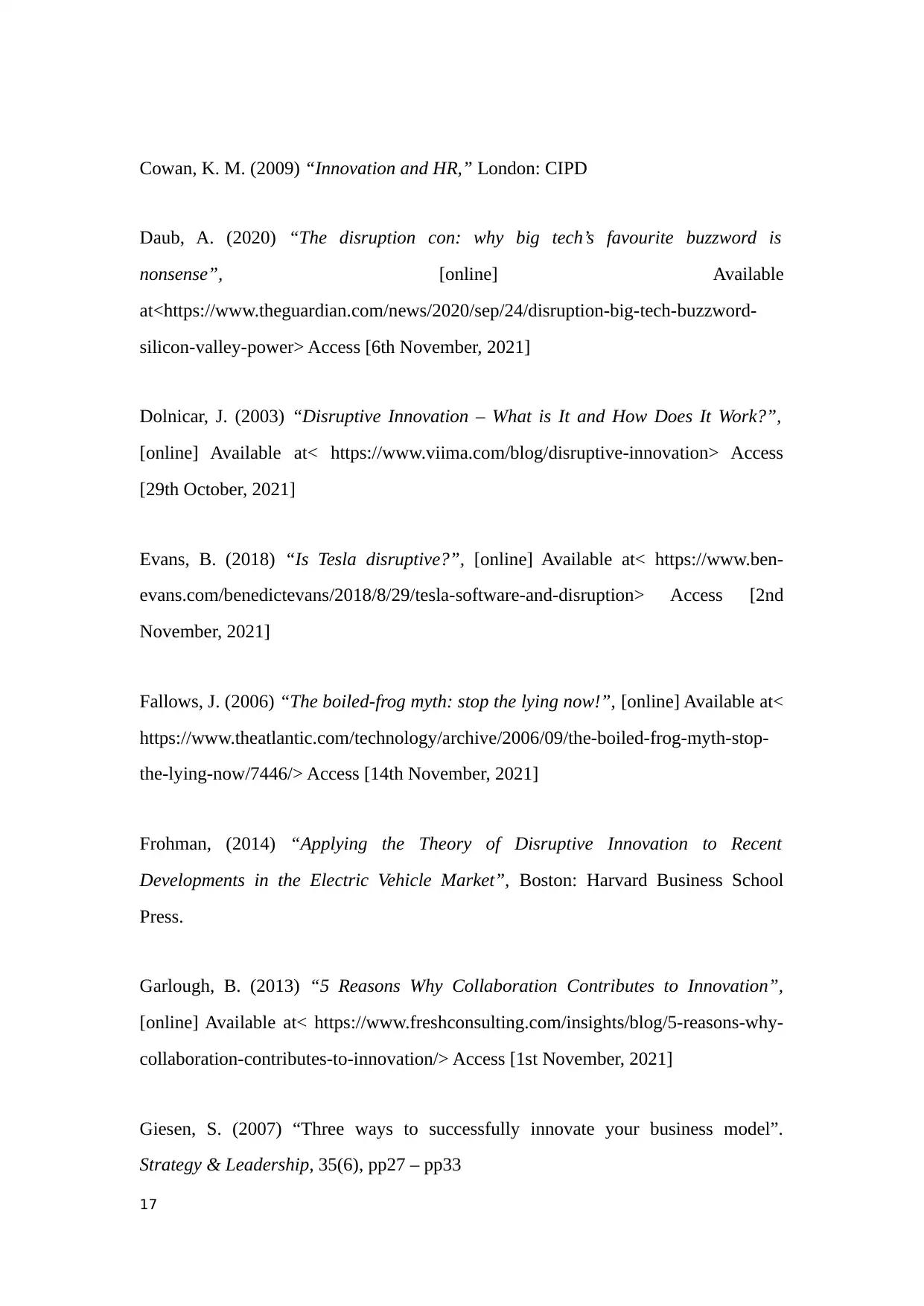
Cowan, K. M. (2009) “Innovation and HR,” London: CIPD
Daub, A. (2020) “The disruption con: why big tech’s favourite buzzword is
nonsense”, [online] Available
at<https://www.theguardian.com/news/2020/sep/24/disruption-big-tech-buzzword-
silicon-valley-power> Access [6th November, 2021]
Dolnicar, J. (2003) “Disruptive Innovation – What is It and How Does It Work?”,
[online] Available at< https://www.viima.com/blog/disruptive-innovation> Access
[29th October, 2021]
Evans, B. (2018) “Is Tesla disruptive?”, [online] Available at< https://www.ben-
evans.com/benedictevans/2018/8/29/tesla-software-and-disruption> Access [2nd
November, 2021]
Fallows, J. (2006) “The boiled-frog myth: stop the lying now!”, [online] Available at<
https://www.theatlantic.com/technology/archive/2006/09/the-boiled-frog-myth-stop-
the-lying-now/7446/> Access [14th November, 2021]
Frohman, (2014) “Applying the Theory of Disruptive Innovation to Recent
Developments in the Electric Vehicle Market”, Boston: Harvard Business School
Press.
Garlough, B. (2013) “5 Reasons Why Collaboration Contributes to Innovation”,
[online] Available at< https://www.freshconsulting.com/insights/blog/5-reasons-why-
collaboration-contributes-to-innovation/> Access [1st November, 2021]
Giesen, S. (2007) “Three ways to successfully innovate your business model”.
Strategy & Leadership, 35(6), pp27 – pp33
17
Daub, A. (2020) “The disruption con: why big tech’s favourite buzzword is
nonsense”, [online] Available
at<https://www.theguardian.com/news/2020/sep/24/disruption-big-tech-buzzword-
silicon-valley-power> Access [6th November, 2021]
Dolnicar, J. (2003) “Disruptive Innovation – What is It and How Does It Work?”,
[online] Available at< https://www.viima.com/blog/disruptive-innovation> Access
[29th October, 2021]
Evans, B. (2018) “Is Tesla disruptive?”, [online] Available at< https://www.ben-
evans.com/benedictevans/2018/8/29/tesla-software-and-disruption> Access [2nd
November, 2021]
Fallows, J. (2006) “The boiled-frog myth: stop the lying now!”, [online] Available at<
https://www.theatlantic.com/technology/archive/2006/09/the-boiled-frog-myth-stop-
the-lying-now/7446/> Access [14th November, 2021]
Frohman, (2014) “Applying the Theory of Disruptive Innovation to Recent
Developments in the Electric Vehicle Market”, Boston: Harvard Business School
Press.
Garlough, B. (2013) “5 Reasons Why Collaboration Contributes to Innovation”,
[online] Available at< https://www.freshconsulting.com/insights/blog/5-reasons-why-
collaboration-contributes-to-innovation/> Access [1st November, 2021]
Giesen, S. (2007) “Three ways to successfully innovate your business model”.
Strategy & Leadership, 35(6), pp27 – pp33
17
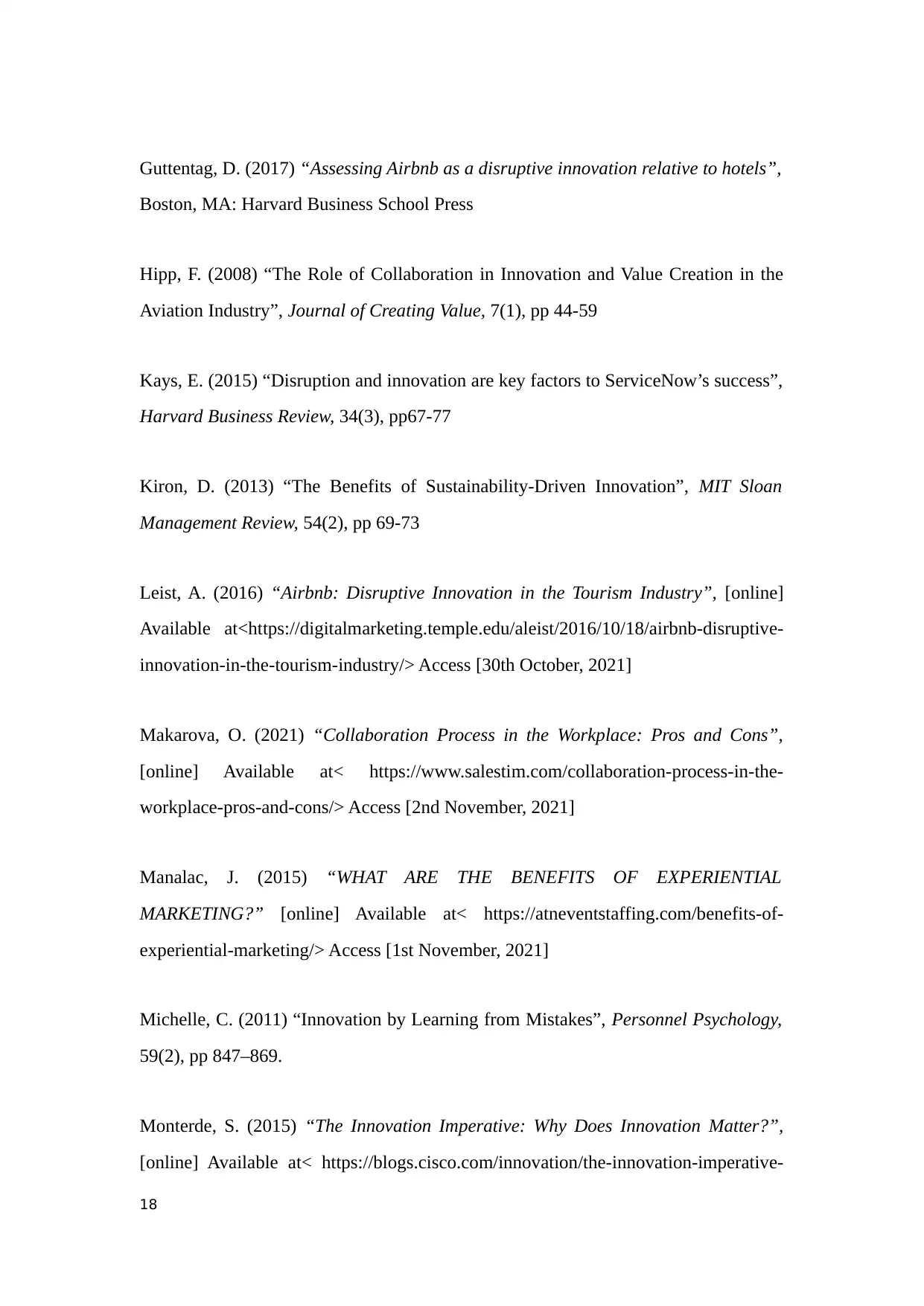
Guttentag, D. (2017) “Assessing Airbnb as a disruptive innovation relative to hotels”,
Boston, MA: Harvard Business School Press
Hipp, F. (2008) “The Role of Collaboration in Innovation and Value Creation in the
Aviation Industry”, Journal of Creating Value, 7(1), pp 44-59
Kays, E. (2015) “Disruption and innovation are key factors to ServiceNow’s success”,
Harvard Business Review, 34(3), pp67-77
Kiron, D. (2013) “The Benefits of Sustainability-Driven Innovation”, MIT Sloan
Management Review, 54(2), pp 69-73
Leist, A. (2016) “Airbnb: Disruptive Innovation in the Tourism Industry”, [online]
Available at<https://digitalmarketing.temple.edu/aleist/2016/10/18/airbnb-disruptive-
innovation-in-the-tourism-industry/> Access [30th October, 2021]
Makarova, O. (2021) “Collaboration Process in the Workplace: Pros and Cons”,
[online] Available at< https://www.salestim.com/collaboration-process-in-the-
workplace-pros-and-cons/> Access [2nd November, 2021]
Manalac, J. (2015) “WHAT ARE THE BENEFITS OF EXPERIENTIAL
MARKETING?” [online] Available at< https://atneventstaffing.com/benefits-of-
experiential-marketing/> Access [1st November, 2021]
Michelle, C. (2011) “Innovation by Learning from Mistakes”, Personnel Psychology,
59(2), pp 847–869.
Monterde, S. (2015) “The Innovation Imperative: Why Does Innovation Matter?”,
[online] Available at< https://blogs.cisco.com/innovation/the-innovation-imperative-
18
Boston, MA: Harvard Business School Press
Hipp, F. (2008) “The Role of Collaboration in Innovation and Value Creation in the
Aviation Industry”, Journal of Creating Value, 7(1), pp 44-59
Kays, E. (2015) “Disruption and innovation are key factors to ServiceNow’s success”,
Harvard Business Review, 34(3), pp67-77
Kiron, D. (2013) “The Benefits of Sustainability-Driven Innovation”, MIT Sloan
Management Review, 54(2), pp 69-73
Leist, A. (2016) “Airbnb: Disruptive Innovation in the Tourism Industry”, [online]
Available at<https://digitalmarketing.temple.edu/aleist/2016/10/18/airbnb-disruptive-
innovation-in-the-tourism-industry/> Access [30th October, 2021]
Makarova, O. (2021) “Collaboration Process in the Workplace: Pros and Cons”,
[online] Available at< https://www.salestim.com/collaboration-process-in-the-
workplace-pros-and-cons/> Access [2nd November, 2021]
Manalac, J. (2015) “WHAT ARE THE BENEFITS OF EXPERIENTIAL
MARKETING?” [online] Available at< https://atneventstaffing.com/benefits-of-
experiential-marketing/> Access [1st November, 2021]
Michelle, C. (2011) “Innovation by Learning from Mistakes”, Personnel Psychology,
59(2), pp 847–869.
Monterde, S. (2015) “The Innovation Imperative: Why Does Innovation Matter?”,
[online] Available at< https://blogs.cisco.com/innovation/the-innovation-imperative-
18
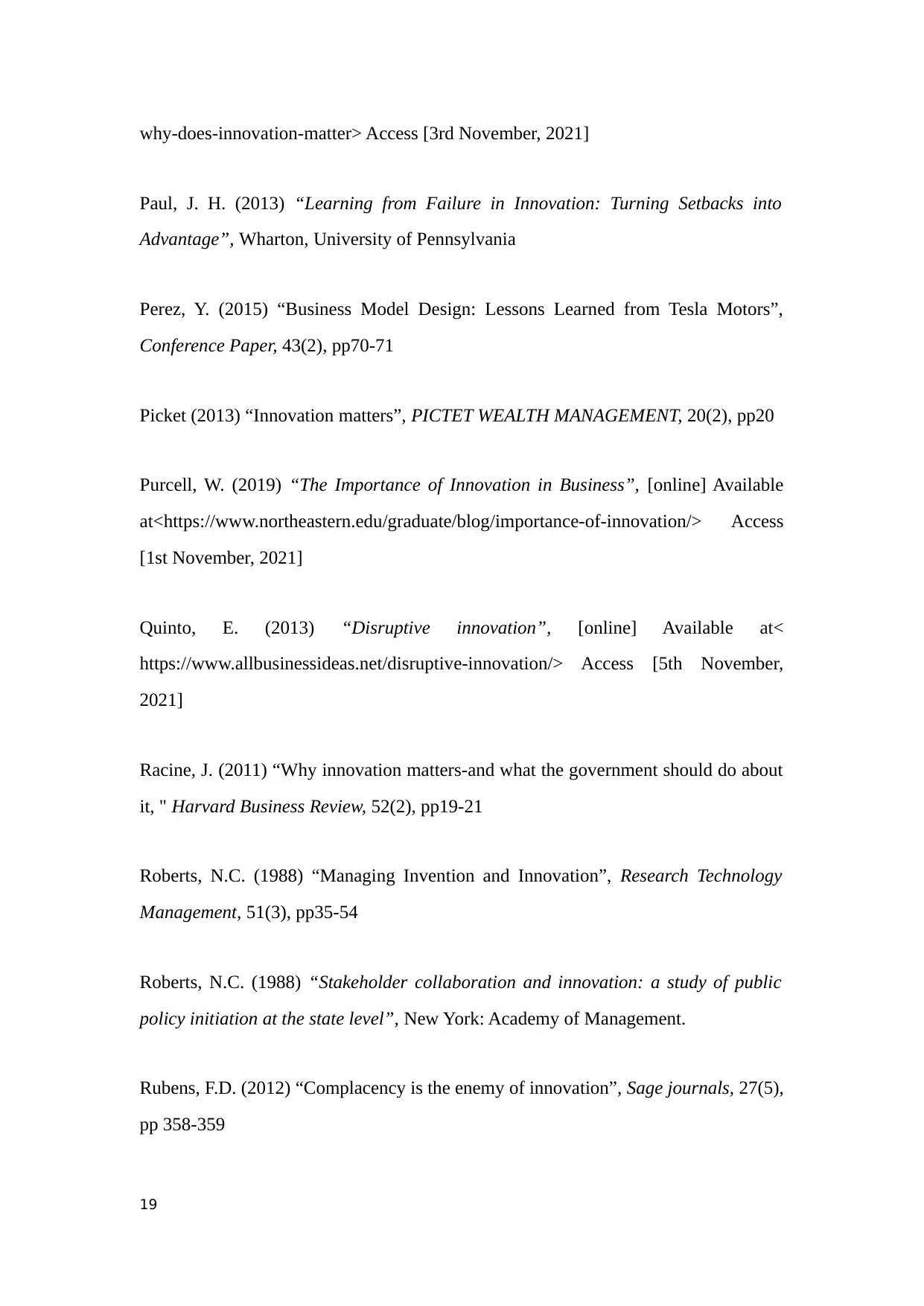
why-does-innovation-matter> Access [3rd November, 2021]
Paul, J. H. (2013) “Learning from Failure in Innovation: Turning Setbacks into
Advantage”, Wharton, University of Pennsylvania
Perez, Y. (2015) “Business Model Design: Lessons Learned from Tesla Motors”,
Conference Paper, 43(2), pp70-71
Picket (2013) “Innovation matters”, PICTET WEALTH MANAGEMENT, 20(2), pp20
Purcell, W. (2019) “The Importance of Innovation in Business”, [online] Available
at<https://www.northeastern.edu/graduate/blog/importance-of-innovation/> Access
[1st November, 2021]
Quinto, E. (2013) “Disruptive innovation”, [online] Available at<
https://www.allbusinessideas.net/disruptive-innovation/> Access [5th November,
2021]
Racine, J. (2011) “Why innovation matters-and what the government should do about
it, " Harvard Business Review, 52(2), pp19-21
Roberts, N.C. (1988) “Managing Invention and Innovation”, Research Technology
Management, 51(3), pp35-54
Roberts, N.C. (1988) “Stakeholder collaboration and innovation: a study of public
policy initiation at the state level”, New York: Academy of Management.
Rubens, F.D. (2012) “Complacency is the enemy of innovation”, Sage journals, 27(5),
pp 358-359
19
Paul, J. H. (2013) “Learning from Failure in Innovation: Turning Setbacks into
Advantage”, Wharton, University of Pennsylvania
Perez, Y. (2015) “Business Model Design: Lessons Learned from Tesla Motors”,
Conference Paper, 43(2), pp70-71
Picket (2013) “Innovation matters”, PICTET WEALTH MANAGEMENT, 20(2), pp20
Purcell, W. (2019) “The Importance of Innovation in Business”, [online] Available
at<https://www.northeastern.edu/graduate/blog/importance-of-innovation/> Access
[1st November, 2021]
Quinto, E. (2013) “Disruptive innovation”, [online] Available at<
https://www.allbusinessideas.net/disruptive-innovation/> Access [5th November,
2021]
Racine, J. (2011) “Why innovation matters-and what the government should do about
it, " Harvard Business Review, 52(2), pp19-21
Roberts, N.C. (1988) “Managing Invention and Innovation”, Research Technology
Management, 51(3), pp35-54
Roberts, N.C. (1988) “Stakeholder collaboration and innovation: a study of public
policy initiation at the state level”, New York: Academy of Management.
Rubens, F.D. (2012) “Complacency is the enemy of innovation”, Sage journals, 27(5),
pp 358-359
19
Paraphrase This Document
Need a fresh take? Get an instant paraphrase of this document with our AI Paraphraser
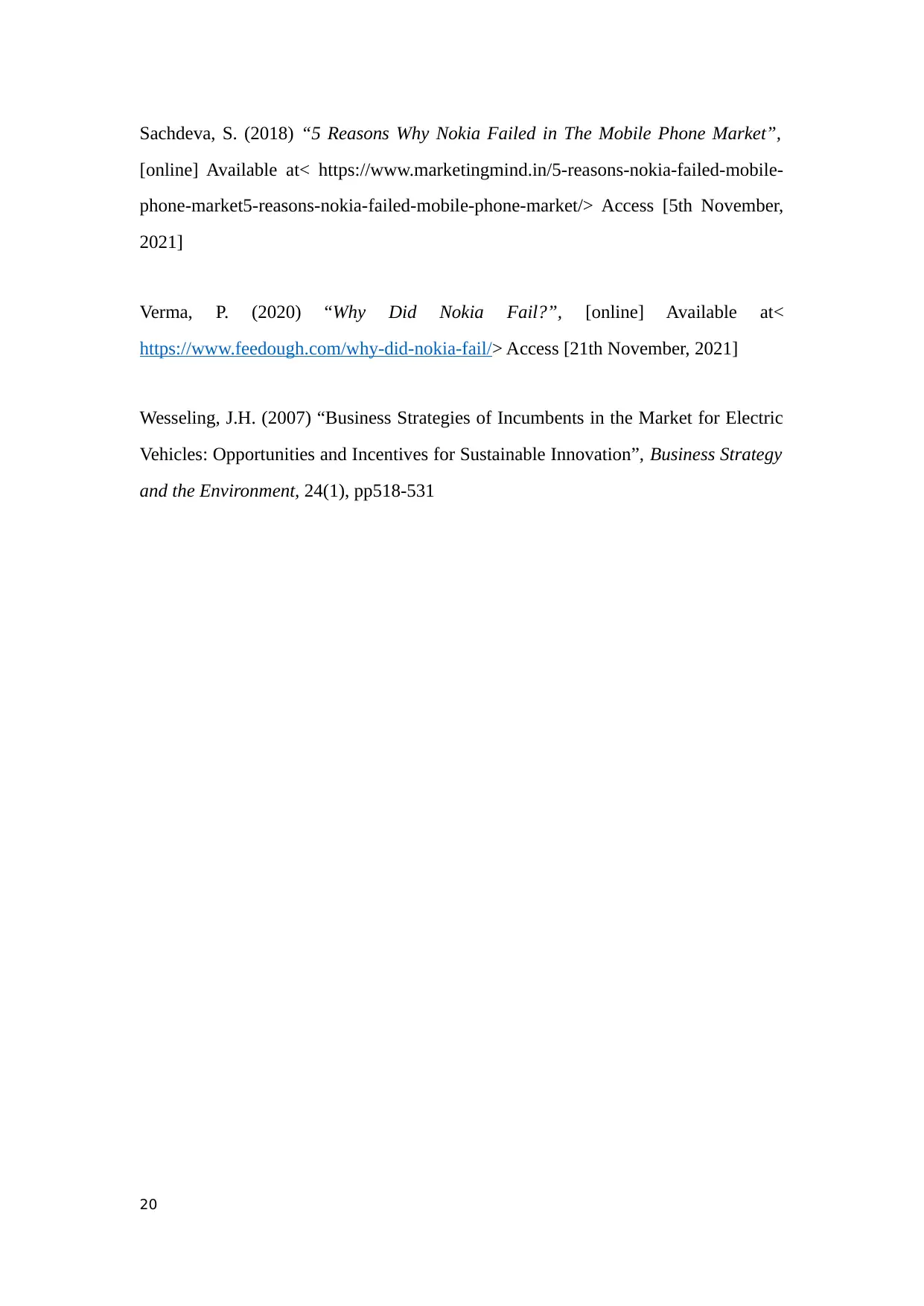
Sachdeva, S. (2018) “5 Reasons Why Nokia Failed in The Mobile Phone Market”,
[online] Available at< https://www.marketingmind.in/5-reasons-nokia-failed-mobile-
phone-market5-reasons-nokia-failed-mobile-phone-market/> Access [5th November,
2021]
Verma, P. (2020) “Why Did Nokia Fail?”, [online] Available at<
https://www.feedough.com/why-did-nokia-fail/> Access [21th November, 2021]
Wesseling, J.H. (2007) “Business Strategies of Incumbents in the Market for Electric
Vehicles: Opportunities and Incentives for Sustainable Innovation”, Business Strategy
and the Environment, 24(1), pp518-531
20
[online] Available at< https://www.marketingmind.in/5-reasons-nokia-failed-mobile-
phone-market5-reasons-nokia-failed-mobile-phone-market/> Access [5th November,
2021]
Verma, P. (2020) “Why Did Nokia Fail?”, [online] Available at<
https://www.feedough.com/why-did-nokia-fail/> Access [21th November, 2021]
Wesseling, J.H. (2007) “Business Strategies of Incumbents in the Market for Electric
Vehicles: Opportunities and Incentives for Sustainable Innovation”, Business Strategy
and the Environment, 24(1), pp518-531
20
1 out of 20
Your All-in-One AI-Powered Toolkit for Academic Success.
+13062052269
info@desklib.com
Available 24*7 on WhatsApp / Email
![[object Object]](/_next/static/media/star-bottom.7253800d.svg)
Unlock your academic potential
© 2024 | Zucol Services PVT LTD | All rights reserved.

